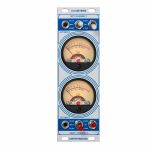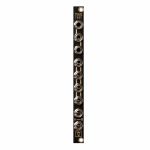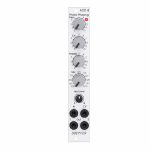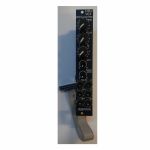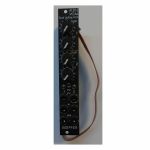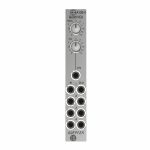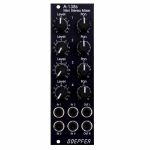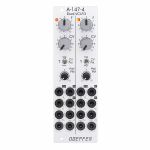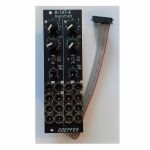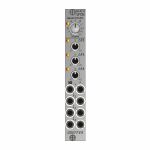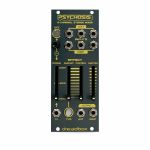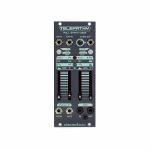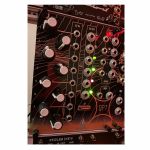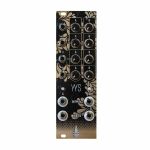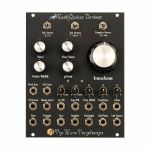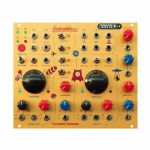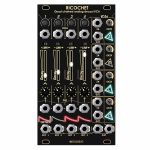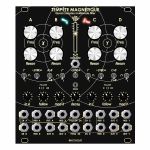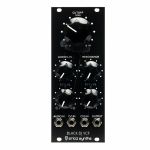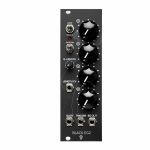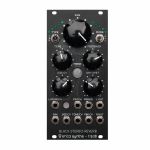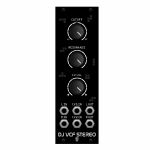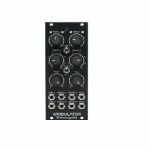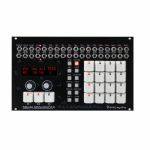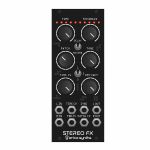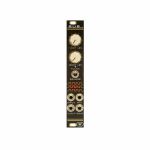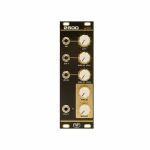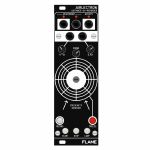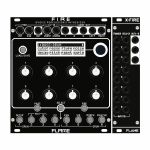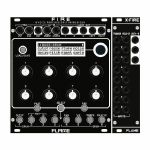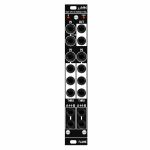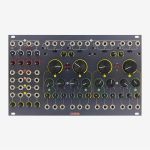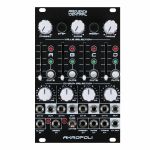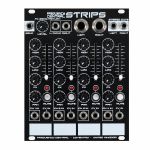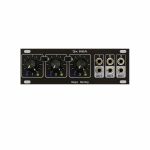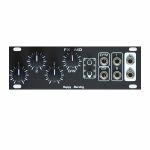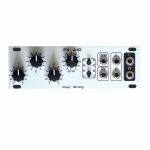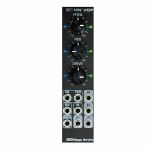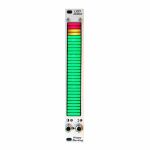100% Compra Segura
Studio equipment
Our full range of studio equipment from all the leading equipment and software brands. Guaranteed fast delivery and low prices.
100% Compra Segura
DJ equipment
Our full range of DJ equipment from all the leading equipment and software brands. Guaranteed fast delivery and low prices. Visit Juno DJ
Filter
Synth modules
The Eurorack modular synth format is one of the most exciting areas of music technology. Pioneered by Doepfer, there are now hundreds of brands offering compatible modules of all varieties. You can combine your choice of the best oscillators, filters and much more in order to create a unique, bespoke synth setup which perfectly suits your needs.
Eurorack modules offer the biggest range of options you can imagine, from basic analogue modules which replicate the sound of classic vintage synths, through to digital modules which allow you to explore completely new approaches to making music.
Whether you’re a beginner or a more experienced modular head, you can take your pick of the best modules from leading brands including Mutable Instruments and ALM Busy Circuits.
Our range also includes accessories, cases, patch cables and much more, allowing you to build and customise your perfect modular synth setup.

Dannysound Timbre Buchla 259 Inspired Wavefolder Module (mixer/waveshaper synth module)
Cat: 967621 Rel: 15 Sep 23
Buchla 259 inspired wavefolder module - 6HP.
Notes: The Timbre is a 6HP Eurorack module based on the wave folder section of the Buchla 259 oscillator as implemented in the Music Easel.
The wave folder adds extra harmonics to input signals that have low harmonic content to create rich and interesting timbres. Typical input sources to use would be Sine and Triangle waves but you are welcome to try other sources as well! The Dannysound Timbre adds an extra input to the Buchla design to allow 2 oscillators to drive the wave-folder simultaneously - this dramatically increases the range of possible tones that can be generated and allows the folder to go wild!
Features:
Osc1 / Osc2 Mix - Adjusts the mix between the Oscillator 1 and 2 inputs, also acts as an attenuator if only one input is used.
Timbre Control - Adjusts the overall amount of wave fold
Timbre CV - Bipolar (attenuator) controls the Timbre CV input
Symmetry - Adds an offset to the input so that the top half of the wave begins to fold earlier
Blend - Mixes between the clean and effected sound
Power consumption: 46mA at +12V and 48mA at -12V
Depth: 25mm
HP : 6
… Read moreThe wave folder adds extra harmonics to input signals that have low harmonic content to create rich and interesting timbres. Typical input sources to use would be Sine and Triangle waves but you are welcome to try other sources as well! The Dannysound Timbre adds an extra input to the Buchla design to allow 2 oscillators to drive the wave-folder simultaneously - this dramatically increases the range of possible tones that can be generated and allows the folder to go wild!
Features:
Osc1 / Osc2 Mix - Adjusts the mix between the Oscillator 1 and 2 inputs, also acts as an attenuator if only one input is used.
Timbre Control - Adjusts the overall amount of wave fold
Timbre CV - Bipolar (attenuator) controls the Timbre CV input
Symmetry - Adds an offset to the input so that the top half of the wave begins to fold earlier
Blend - Mixes between the clean and effected sound
Power consumption: 46mA at +12V and 48mA at -12V
Depth: 25mm
HP : 6
1 in stock $245.45
Click for better price!
or call +44 20 7424 1960
quote 967621
quote 967621
Dannysound VU Meters Analogue VU Meters Expander Module For Dynamics (dynamics/expander synth module)
Cat: 967625 Rel: 15 Sep 23
Analogue VU meters expander module for the Dynamics module - 8HP.
Notes: The Dannysound VU Meters is designed to be used with 2 x Dynamics modules. The modules connect internally via 2x3 pin ribbon cables. The meters provide a visual representation of various signals within the Dynamics modules making settings easier.
Features:
External input sockets for monitoring external sources.
Switch to select high or low meter sensitivity or off if the clicking needles get annoying!
Monitoring of the compression/expansion amount.
Monitoring of the unprocessed input level.
Monitoring of the compressor/expander output level.
Power consumption: 0.03mA at +12V and 83mA at -12V at and 3mA at +5V
Depth: 51mm
HP : 8
… Read moreFeatures:
External input sockets for monitoring external sources.
Switch to select high or low meter sensitivity or off if the clicking needles get annoying!
Monitoring of the compression/expansion amount.
Monitoring of the unprocessed input level.
Monitoring of the compressor/expander output level.
Power consumption: 0.03mA at +12V and 83mA at -12V at and 3mA at +5V
Depth: 51mm
HP : 8
1 in stock $215.54
Click for better price!
or call +44 20 7424 1960
quote 967625
quote 967625
Der Mann Mit Der Maschine R2M/R2C Controller Remote Connection Modules For Droid Master (pair) (controller/uility module)
Cat: 971155 Rel: 06 Nov 23
R2M/R2C: two controller remote connection modules for the Droid Master - 2HP each.
Notes: R2M is module 1 of a pair of two 2 HP modules that allow you to connect a chain of controllers to your DROID master through a standard 3.5 mm stereo cable (sometimes also called aux-cable).
The usual idea is that you put all your DROID controllers into a skiff case and mount your DROID master, X7 and G8 into another case, together with all your fancy Eurorack sound modules.
R2C is module 2 of a pair of two 2 HP modules that allow you to connect a chain of controllers to your DROID master through a standard 3.5 mm stereo cable (sometimes also called aux-cable).
The usual idea is that you put all your DROID controllers into a skiff case and mount your DROID master, X7 and G8 into another case, together with all your fancy Eurorack sound modules.
While you could do this with the typical 6-pin ribbon connector (e.g. the 80 cm version that we offer), using the R2M/R2C combination has some serious advantages:
The connection cable can be almost arbitrary long (20 m have been tested and works perfectly).
Since the connection is done on the front of the modules, you can quickly disconnect your skiff for the purpose of travelling to a gig.
You can use a standard 3.5 mm stereo TRS cable for the connection.
These modules are not just passive connectors but contain special driver ICs that transform the electronic voltage levels, which run in the 6-pin ribbon, to something more stable and reliable that is fit for longer distances in a more hostile environment.
The controllers do not receive their power from the master but from the R2C module, which has a power connector and a voltage regulator for that purpose. Each chain of the R2C module provides the same power to its controller chain as the master does (it contains the identical voltage regulator). That means that you can connect up to 32 controllers (!) to one R2C.
Another nice thing: The R2M/R2C combination allows for two of these master / controller connections in parallel. That means that you can have two masters being attached to their individual controller chains. That does not mean, that each of the masters can access each of the controllers at the same time, however. Both master / controller connections work completely separately.
Package contents:
* one R2M module
* one R2C module
* one Eurorack power cable for the R2C
* two 6-pin ribbon cables for connecting the R2M to two masters
* two 3.5 mm stereo TRS cables, approx.. 1.2 m
* 4 red M3 screws for mounting the two modules
… Read moreThe usual idea is that you put all your DROID controllers into a skiff case and mount your DROID master, X7 and G8 into another case, together with all your fancy Eurorack sound modules.
R2C is module 2 of a pair of two 2 HP modules that allow you to connect a chain of controllers to your DROID master through a standard 3.5 mm stereo cable (sometimes also called aux-cable).
The usual idea is that you put all your DROID controllers into a skiff case and mount your DROID master, X7 and G8 into another case, together with all your fancy Eurorack sound modules.
While you could do this with the typical 6-pin ribbon connector (e.g. the 80 cm version that we offer), using the R2M/R2C combination has some serious advantages:
The connection cable can be almost arbitrary long (20 m have been tested and works perfectly).
Since the connection is done on the front of the modules, you can quickly disconnect your skiff for the purpose of travelling to a gig.
You can use a standard 3.5 mm stereo TRS cable for the connection.
These modules are not just passive connectors but contain special driver ICs that transform the electronic voltage levels, which run in the 6-pin ribbon, to something more stable and reliable that is fit for longer distances in a more hostile environment.
The controllers do not receive their power from the master but from the R2C module, which has a power connector and a voltage regulator for that purpose. Each chain of the R2C module provides the same power to its controller chain as the master does (it contains the identical voltage regulator). That means that you can connect up to 32 controllers (!) to one R2C.
Another nice thing: The R2M/R2C combination allows for two of these master / controller connections in parallel. That means that you can have two masters being attached to their individual controller chains. That does not mean, that each of the masters can access each of the controllers at the same time, however. Both master / controller connections work completely separately.
Package contents:
* one R2M module
* one R2C module
* one Eurorack power cable for the R2C
* two 6-pin ribbon cables for connecting the R2M to two masters
* two 3.5 mm stereo TRS cables, approx.. 1.2 m
* 4 red M3 screws for mounting the two modules
1 in stock $138.97
Click for better price!
or call +44 20 7424 1960
quote 971155
quote 971155
Der Mann Mit Der Maschine TRS Split CV/Audio Signal Distributor Module (dual/stereo/MIDI/utility module)
Cat: 1005286 Rel: 07 Mar 24
CV & audio signal distributor module - 2HP
Notes: TRS Split - CV/Audio signal distributor
TRS Split is a multipurpose CV and audio signal distribution module. It has three 3.5 mm TRS (tip/ring/sleeve - stereo) jacks and six ordinary 3.5 mm mono jacks.
It contains 3 identical sections set up as following:
Upper jack carries the tip signal
Middle jack carries the stereo/dual signal
Lower jack carries the ring signal
Each section can either split a stereo signal into two mono signals or join two mono signals into one stereo signal. The module does not have any active components and does not need a power supply.
Use cases:
When you plug a stereo signal carried by a stereo (TRS) cable into the middle jack, you receive two separate mono signals by plugging in a mono (TS) cable in the upper jack to carry the left signal and a mono (TS) cable in the lower jack to carry the right signal. That way you can attack an "AUX" cable such as from your smartphone to your modular.
Or the other way around: Send two separate mono signals by plugging in a mono (TS) cable in the upper jack to carry the left signal and a mono (TS) cable in the lower jack to carry the right signal. Receive a stereo signal at the middle jack to be used with a stereo (TRS) cable.
Converting from stereo to dual mono and back allows you to alter the two sides of a stereo signal with different effects/filters.
Some tuners such as the Korg NTS-2 accept inputs to tune two oscillators combined in one 3.5 mm stereo jack. With one splitter you can easily feed two VCO signals into such a tuner.
Switching sides
Two splitters can be used to switch tip and ring (left and right): Plug in a stereo cable in the middle jack of the first section. Connect mono cables to the upper and lower jack of the first section. Then connect the upper mono cable of the first section to the lower mono jack of the second section and the lower mono cable of the first section to the upper mono jack of the second section. The signals are switched. Plug a stereo cable in the middle of the second splitter and you're good to go.
Hint: This also works for MIDI signals. If you use MIDI over minijack, there are two standards A and B - some manufacturers use A some B - thus not all connections are working. Now you can easily switch between the standards using the TRS Split.
Note: The MIDI input of the DROID X7 automatically detects A and B, so there is no switching necessary. The MIDI output of the X7 can be set to A or B with a switch on the back of the module.
Stereo multiple setup
If you have a separate multiple in your modular, you can use the TRS-SPLIT to create a 1:2 stereo multiple as follows:
Plug a stereo cable in the middle jack of section 1, patch the mono cable from the upper jack into section 1 of your multiple (e.g. a 3/3/3 multiple) and feed two of the outputs back into the upper jacks of section 2 and 3. Do the same with the mono cable coming from the lower jack of section 1 going into the second section of a 3/3/3 multiple and patch two cables back into the lower jacks of section 2 and 3 of the TRS Split. Now the middle jacks of section 2 and 3 both carry the stereo signal.
Dimensions
2 HP
22 mm deep
Current Draw
Module does not draw current
… Read moreTRS Split is a multipurpose CV and audio signal distribution module. It has three 3.5 mm TRS (tip/ring/sleeve - stereo) jacks and six ordinary 3.5 mm mono jacks.
It contains 3 identical sections set up as following:
Upper jack carries the tip signal
Middle jack carries the stereo/dual signal
Lower jack carries the ring signal
Each section can either split a stereo signal into two mono signals or join two mono signals into one stereo signal. The module does not have any active components and does not need a power supply.
Use cases:
When you plug a stereo signal carried by a stereo (TRS) cable into the middle jack, you receive two separate mono signals by plugging in a mono (TS) cable in the upper jack to carry the left signal and a mono (TS) cable in the lower jack to carry the right signal. That way you can attack an "AUX" cable such as from your smartphone to your modular.
Or the other way around: Send two separate mono signals by plugging in a mono (TS) cable in the upper jack to carry the left signal and a mono (TS) cable in the lower jack to carry the right signal. Receive a stereo signal at the middle jack to be used with a stereo (TRS) cable.
Converting from stereo to dual mono and back allows you to alter the two sides of a stereo signal with different effects/filters.
Some tuners such as the Korg NTS-2 accept inputs to tune two oscillators combined in one 3.5 mm stereo jack. With one splitter you can easily feed two VCO signals into such a tuner.
Switching sides
Two splitters can be used to switch tip and ring (left and right): Plug in a stereo cable in the middle jack of the first section. Connect mono cables to the upper and lower jack of the first section. Then connect the upper mono cable of the first section to the lower mono jack of the second section and the lower mono cable of the first section to the upper mono jack of the second section. The signals are switched. Plug a stereo cable in the middle of the second splitter and you're good to go.
Hint: This also works for MIDI signals. If you use MIDI over minijack, there are two standards A and B - some manufacturers use A some B - thus not all connections are working. Now you can easily switch between the standards using the TRS Split.
Note: The MIDI input of the DROID X7 automatically detects A and B, so there is no switching necessary. The MIDI output of the X7 can be set to A or B with a switch on the back of the module.
Stereo multiple setup
If you have a separate multiple in your modular, you can use the TRS-SPLIT to create a 1:2 stereo multiple as follows:
Plug a stereo cable in the middle jack of section 1, patch the mono cable from the upper jack into section 1 of your multiple (e.g. a 3/3/3 multiple) and feed two of the outputs back into the upper jacks of section 2 and 3. Do the same with the mono cable coming from the lower jack of section 1 going into the second section of a 3/3/3 multiple and patch two cables back into the lower jacks of section 2 and 3 of the TRS Split. Now the middle jacks of section 2 and 3 both carry the stereo signal.
Dimensions
2 HP
22 mm deep
Current Draw
Module does not draw current
1 in stock $49.24
Click for better price!
or call +44 20 7424 1960
quote 1005286
quote 1005286
Der Mann Mit Der Maschine TRS Tool Stereo/Dual CV/Audio/MIDI Signal Multipurpose Module (dual/stereo/MIDI/multiple module)
Cat: 1005290 Rel: 07 Mar 24
Stereo & dual CV, audio & MIDI signal multipurpose module - 2HP
Notes: TRS Tool - Stereo/Dual CV/Audio/MIDI signal multipurpose module
TRS Tool is a multipurpose CV and audio signal distribution module for working with 3.5 mm stereo jacks (tip/ring/sleeve). These jacks are common for stereo audio but also for MIDI.
The TRS TOOL has no active components and does not need a power supply. It contains 3 different sections set up as following from top to bottom:
TRS Split
The upper jack carries the tip signal
The middle jack carries the stereo/dual signal
The Lower jack carries the ring signal
Use cases:
When you plug a stereo signal carried by a stereo (TRS) cable into the middle jack, you receive two separate mono signals by plugging in a mono (TS) cable in the upper jack to carry the left signal and a mono (TS) cable in the lower jack to carry the right signal. That way you can attack an "AUX" cable such as from your smartphone to your modular.
Or the other way around: Send two separate mono signals by plugging in a mono (TS) cable in the upper jack to carry the left signal and a mono (TS) cable in the lower jack to carry the right signal. Receive a stereo signal at the middle jack to be used with a stereo (TRS) cable.
Converting from stereo to dual mono and back allows you to alter the two sides of a stereo signal with different effects/filters.
Some tuners such as the Korg NTS-2 accept inputs to tune two oscillators combined in one 3.5 mm stereo jack. With one splitter you can easily feed two VCO signals into such a tuner.
TRS Quad Multiple
Multiply a stereo signal. Four TRS jacks to be used with stereo minijack cables.
Use cases:
You could use this to multiply the signal for headphones - listen to patches together.
Or create sends - route one (or two) stereo signals to effects and use the third one as dry signal going to the mixer.
Experimental: multiply a MIDI signal to two or three receivers: NOTE: depending on the output power of the MIDI sender and the power draw of the MIDI receivers this might or might not work. MIDI uses a current of typically 5 mA instead of voltage levels for data transmission. So when you attach too many devices to one output the current might not be enough to drive all of them. So this is strictly spoken not covered by the MIDI standard, but might work anyway.
A/B Swapper
The bottom section of the module consists of two connected TRS jacks.
Whatever signal applies to the tip in jack A will be routed to the ring in jack B.
Whatever signal applies to the ring in jack A will be routed to the tip in jack B.
Use cases:
Switch the left and right side of a stereo audio signal.
Switch between MIDI standard A and B: If you use MIDI over minijack, there's two standards A and B - some manufacturers use A some B - thus not all connections are working. Now you can easily switch between the standards using the TRS Split.
Note: The MIDI input of the DROID X7 automatically detects A and B, so there is no switching necessary. The MIDI output of the X7 can be set to A or B with a switch on the back of the module.
Dimensions
2 HP
22 mm deep
Current Draw
Module does not draw current
… Read moreTRS Tool is a multipurpose CV and audio signal distribution module for working with 3.5 mm stereo jacks (tip/ring/sleeve). These jacks are common for stereo audio but also for MIDI.
The TRS TOOL has no active components and does not need a power supply. It contains 3 different sections set up as following from top to bottom:
TRS Split
The upper jack carries the tip signal
The middle jack carries the stereo/dual signal
The Lower jack carries the ring signal
Use cases:
When you plug a stereo signal carried by a stereo (TRS) cable into the middle jack, you receive two separate mono signals by plugging in a mono (TS) cable in the upper jack to carry the left signal and a mono (TS) cable in the lower jack to carry the right signal. That way you can attack an "AUX" cable such as from your smartphone to your modular.
Or the other way around: Send two separate mono signals by plugging in a mono (TS) cable in the upper jack to carry the left signal and a mono (TS) cable in the lower jack to carry the right signal. Receive a stereo signal at the middle jack to be used with a stereo (TRS) cable.
Converting from stereo to dual mono and back allows you to alter the two sides of a stereo signal with different effects/filters.
Some tuners such as the Korg NTS-2 accept inputs to tune two oscillators combined in one 3.5 mm stereo jack. With one splitter you can easily feed two VCO signals into such a tuner.
TRS Quad Multiple
Multiply a stereo signal. Four TRS jacks to be used with stereo minijack cables.
Use cases:
You could use this to multiply the signal for headphones - listen to patches together.
Or create sends - route one (or two) stereo signals to effects and use the third one as dry signal going to the mixer.
Experimental: multiply a MIDI signal to two or three receivers: NOTE: depending on the output power of the MIDI sender and the power draw of the MIDI receivers this might or might not work. MIDI uses a current of typically 5 mA instead of voltage levels for data transmission. So when you attach too many devices to one output the current might not be enough to drive all of them. So this is strictly spoken not covered by the MIDI standard, but might work anyway.
A/B Swapper
The bottom section of the module consists of two connected TRS jacks.
Whatever signal applies to the tip in jack A will be routed to the ring in jack B.
Whatever signal applies to the ring in jack A will be routed to the tip in jack B.
Use cases:
Switch the left and right side of a stereo audio signal.
Switch between MIDI standard A and B: If you use MIDI over minijack, there's two standards A and B - some manufacturers use A some B - thus not all connections are working. Now you can easily switch between the standards using the TRS Split.
Note: The MIDI input of the DROID X7 automatically detects A and B, so there is no switching necessary. The MIDI output of the X7 can be set to A or B with a switch on the back of the module.
Dimensions
2 HP
22 mm deep
Current Draw
Module does not draw current
1 in stock $49.24
Click for better price!
or call +44 20 7424 1960
quote 1005290
quote 1005290
Doepfer A-101-8 Photo Phasing 8-Stage Phase Shifter Module (silver) (phase shifter/effect synth module)
Cat: 945411 Rel: 13 Jun 23
An eight stage phase shifter module in 4HP.
Notes: Module A-101-8 is a 8-stage phase shifter which uses light-sensitive resistors (LDR) and is a replica of the Compact Phasing A manufactured by the company Schulte in the seventies. The actual phasing circuit is identical to the historic model. Only the illumination control of the LDRs is different: the A-101-8 uses LEDs to illuminate the LDRs, the historic model used incandescent miniature lamps. And the A-101-8 has no built-in LFO but can be controlled by any external control voltage source (e.g. LFO, ADSR, random, Theremin, ribbon controller, sequencer, midi). The phasing offset (i.e. the base value for the phase shifting) and the modulation depth of the external control signal can be adjusted separately. The Compact Phasing A had no offset control but only a depth control for the built-in LFO. Feedback and mixing ratio of the output signal are set by two controls. The audio input is equipped with an attenuator. The module has two audio outputs available (same as the historic model) and a visual display of the phase shifting.
The module has these controls and in/outputs available:
Control Man. : manual control of the phase shift offset (base value)
Control CV: attenuator for the signal applied to the CV socket
Control Feedb.: Feedback or Resonance (similar function as filter resonance/feedback/emphasis)
Control Mix: sets the mixing ratio between original and phase shift signal appearing at output 1
fully CCW: only the modified input signal appears at output 1 (see note below *)
center: a mixture between the modified input signal and the phase shift signal appears at output 1, that's the standard position for the classical phasing effect
fully CW: the pure phase shifted signal appears at output 1 (e.g. for vibrato effects)
Control Input Level: attenuator for signal applied to the In socket
Socket In: audio input
Socket CV: control voltage input
Socket Out 1: audio output 1 (mix signal)
Socket Out 2: audio output 2 (modified input signal)
LED: visual control of the phase shift
The module has some peculiarities (same as the historic model):
The input signal is processed at first by a pre-stage which outputs a "modified" input signal (*). This signal is not processed by the phase shift stages but is affected by the feedback setting. Only when feedback is set to zero this signal is identical to the input signal. Otherwise it contains feedback components.
This signal is output on socket Out 2.
When both output sockets Out 1 and Out 2 are used as stereo channels one obtains a spatial stereo sound effect.
The same signals is also used for the CCW position of the mix control. With mix control fully CCW the unmodified signal appears only if the feedback control is set to zero. Otherwise it contains feedback components.
The historic model had two audio inputs: one 5-pin DIN socket and a 1/4" jack socket. The DIN socket was intended for high-level line signals. When the 1/4" jack socket was used the amplification of the pre-stage increased by about 100. The 1/4" jack socket was intended for low level signals (e.g. electric guitars or microphones). For this feature the A-101-8 has an internal jumper that can be used to increase the amplification. As long as the module is used within the A-100 system usually the lower amplification is used to avoid distortion.
The 8 photo resistors and LEDs are assembled within an small lighproof box. In addition the pc boards are made of lighproof black material to avoid interfering light from other modules or the bus board.
Dimensions
4 HP
45 mm deep
Current Draw
30 mA +12V
30 mA -12V
… Read moreThe module has these controls and in/outputs available:
Control Man. : manual control of the phase shift offset (base value)
Control CV: attenuator for the signal applied to the CV socket
Control Feedb.: Feedback or Resonance (similar function as filter resonance/feedback/emphasis)
Control Mix: sets the mixing ratio between original and phase shift signal appearing at output 1
fully CCW: only the modified input signal appears at output 1 (see note below *)
center: a mixture between the modified input signal and the phase shift signal appears at output 1, that's the standard position for the classical phasing effect
fully CW: the pure phase shifted signal appears at output 1 (e.g. for vibrato effects)
Control Input Level: attenuator for signal applied to the In socket
Socket In: audio input
Socket CV: control voltage input
Socket Out 1: audio output 1 (mix signal)
Socket Out 2: audio output 2 (modified input signal)
LED: visual control of the phase shift
The module has some peculiarities (same as the historic model):
The input signal is processed at first by a pre-stage which outputs a "modified" input signal (*). This signal is not processed by the phase shift stages but is affected by the feedback setting. Only when feedback is set to zero this signal is identical to the input signal. Otherwise it contains feedback components.
This signal is output on socket Out 2.
When both output sockets Out 1 and Out 2 are used as stereo channels one obtains a spatial stereo sound effect.
The same signals is also used for the CCW position of the mix control. With mix control fully CCW the unmodified signal appears only if the feedback control is set to zero. Otherwise it contains feedback components.
The historic model had two audio inputs: one 5-pin DIN socket and a 1/4" jack socket. The DIN socket was intended for high-level line signals. When the 1/4" jack socket was used the amplification of the pre-stage increased by about 100. The 1/4" jack socket was intended for low level signals (e.g. electric guitars or microphones). For this feature the A-101-8 has an internal jumper that can be used to increase the amplification. As long as the module is used within the A-100 system usually the lower amplification is used to avoid distortion.
The 8 photo resistors and LEDs are assembled within an small lighproof box. In addition the pc boards are made of lighproof black material to avoid interfering light from other modules or the bus board.
Dimensions
4 HP
45 mm deep
Current Draw
30 mA +12V
30 mA -12V
8 in stock $122.47
Click for better price!
or call +44 20 7424 1960
quote 945411
quote 945411
Doepfer A-105-2 24dB Low Pass (SSI-Type) Filter Module (silver) (filter/oscillator synth module)
Cat: 973741 Rel: 14 Nov 23
24dB SSI low pass filter - 4HP.
Notes: Module A-105-2 is a voltage controlled low pass filter with 24dB/octave slope.
It is the successor of the A-105 which had to be discontinued because the obsolete SSM2044 filter circuit. The A-105-2 is based on the SSI2144 which is in turn the successor circuit of the SSM2044. The features of both modules are nearly the same. The main difference is the clearly reduced front panel width of the A-105-2 (4HP instead of 8HP) and the associated changes of the controls and sockets positions. In addition the A-105-2 is equipped with 2 audio inputs.
The module has these controls and in/outputs available:
Control Frequ: manual frequency control
Control FCV2: attenuator for the frequency control voltage applied to socket FCV2
Control Q: manual resonance control
Control QCV: attenuator for the resonance control voltage applied to socket QCV
Control Input 1 Level: attenuator for the audio input signal applied to socket Input 1
Socket Input 1: audio input 1 (with attenuator)
Socket Input 2: audio input 2 (without attenuator)
Socket FCV1: frequency control voltage 1 (without attenuator, about 1V/oct scale)
Socket FCV2: frequency control voltage 2 (with attenuator)
Socket QCV: resonance control voltage (with attenuator)
Socket Out: audio output
Technical notes:
Frequency range: about 15Hz ... 15 kHz
Resonance up to self oscillation
Max. input voltage at Input 2 without clipping/distortion: about 15Vpp
Max. output voltage without clipping/distortion: about 15Vpp
The signals of both inputs are mixed before they are processed by the filter. This saves an external mixer for small setups.
Depth: 45 mm
HP : 4
… Read moreIt is the successor of the A-105 which had to be discontinued because the obsolete SSM2044 filter circuit. The A-105-2 is based on the SSI2144 which is in turn the successor circuit of the SSM2044. The features of both modules are nearly the same. The main difference is the clearly reduced front panel width of the A-105-2 (4HP instead of 8HP) and the associated changes of the controls and sockets positions. In addition the A-105-2 is equipped with 2 audio inputs.
The module has these controls and in/outputs available:
Control Frequ: manual frequency control
Control FCV2: attenuator for the frequency control voltage applied to socket FCV2
Control Q: manual resonance control
Control QCV: attenuator for the resonance control voltage applied to socket QCV
Control Input 1 Level: attenuator for the audio input signal applied to socket Input 1
Socket Input 1: audio input 1 (with attenuator)
Socket Input 2: audio input 2 (without attenuator)
Socket FCV1: frequency control voltage 1 (without attenuator, about 1V/oct scale)
Socket FCV2: frequency control voltage 2 (with attenuator)
Socket QCV: resonance control voltage (with attenuator)
Socket Out: audio output
Technical notes:
Frequency range: about 15Hz ... 15 kHz
Resonance up to self oscillation
Max. input voltage at Input 2 without clipping/distortion: about 15Vpp
Max. output voltage without clipping/distortion: about 15Vpp
The signals of both inputs are mixed before they are processed by the filter. This saves an external mixer for small setups.
Depth: 45 mm
HP : 4
2 in stock $103.13
Doepfer A-105-2v 24dB Low Pass (SSI-Type) Filter Vintage Edition Module (black) (filter/oscillator synth module)
Cat: 973745 Rel: 14 Nov 23
24dB SSI low pass filter module - 4HP.
Notes: Module A-105-2V is a voltage controlled low pass filter with 24dB/octave slope.
It is the successor of the A-105 which had to be discontinued because the obsolete SSM2044 filter circuit. The A-105-2 is based on the SSI2144 which is in turn the successor circuit of the SSM2044. The features of both modules are nearly the same. The main difference is the clearly reduced front panel width of the A-105-2 (4HP instead of 8HP) and the associated changes of the controls and sockets positions. In addition the A-105-2 is equipped with 2 audio inputs.
The module has these controls and in/outputs available:
Control Frequ: manual frequency control
Control FCV2: attenuator for the frequency control voltage applied to socket FCV2
Control Q: manual resonance control
Control QCV: attenuator for the resonance control voltage applied to socket QCV
Control Input 1 Level: attenuator for the audio input signal applied to socket Input 1
Socket Input 1: audio input 1 (with attenuator)
Socket Input 2: audio input 2 (without attenuator)
Socket FCV1: frequency control voltage 1 (without attenuator, about 1V/oct scale)
Socket FCV2: frequency control voltage 2 (with attenuator)
Socket QCV: resonance control voltage (with attenuator)
Socket Out: audio output
Technical notes:
Frequency range: about 15Hz ... 15 kHz
Resonance up to self oscillation
Max. input voltage at Input 2 without clipping/distortion: about 15Vpp
Max. output voltage without clipping/distortion: about 15Vpp
The signals of both inputs are mixed before they are processed by the filter. This saves an external mixer for small setups.
Depth: 45 mm
HP : 4
… Read moreIt is the successor of the A-105 which had to be discontinued because the obsolete SSM2044 filter circuit. The A-105-2 is based on the SSI2144 which is in turn the successor circuit of the SSM2044. The features of both modules are nearly the same. The main difference is the clearly reduced front panel width of the A-105-2 (4HP instead of 8HP) and the associated changes of the controls and sockets positions. In addition the A-105-2 is equipped with 2 audio inputs.
The module has these controls and in/outputs available:
Control Frequ: manual frequency control
Control FCV2: attenuator for the frequency control voltage applied to socket FCV2
Control Q: manual resonance control
Control QCV: attenuator for the resonance control voltage applied to socket QCV
Control Input 1 Level: attenuator for the audio input signal applied to socket Input 1
Socket Input 1: audio input 1 (with attenuator)
Socket Input 2: audio input 2 (without attenuator)
Socket FCV1: frequency control voltage 1 (without attenuator, about 1V/oct scale)
Socket FCV2: frequency control voltage 2 (with attenuator)
Socket QCV: resonance control voltage (with attenuator)
Socket Out: audio output
Technical notes:
Frequency range: about 15Hz ... 15 kHz
Resonance up to self oscillation
Max. input voltage at Input 2 without clipping/distortion: about 15Vpp
Max. output voltage without clipping/distortion: about 15Vpp
The signals of both inputs are mixed before they are processed by the filter. This saves an external mixer for small setups.
Depth: 45 mm
HP : 4
1 in stock $123.75
Click for better price!
or call +44 20 7424 1960
quote 973745
quote 973745
Doepfer A-111-6v Miniature Synthesiser Voice Vintage Edition Module (black) (B-STOCK) (synth voice synth module)
Cat: 970408 Rel: 01 Jan 90
B-STOCK: Slight dent om the edge, otherwise in perfect condition
Notes: ***B-STOCK: Slight dent om the edge, otherwise in perfect condition***
VCO:
- Tune: manual tune control (with an internal jumper the range can be set to ~ +/-1 half an octave or ~ +/-2.5 octaves)
- Oct: range switch -1 / 0 / +1 octave
- Mod: modulation depth (attenuator wired to the Mod. socket)
- Dest: switch that is used to address the modulation to frequency modulation (position FM) or pulsewidth modulation (positon PM), in centre positon no modulation
- PW: manual pulsewidth control for rectangle waveform, PW can be also modulated by the Mod. input as mentioned above
- Wave: waveform switch (sawtooth / off / triangle), the sum of the waveform chosen by this switch and the rectangle is fed into the VCF (to turn the rectangle off the PW control has to be set fully CCW or fully CW)
- 1V/Oct. (socket): external CV input for VCO frequency (1V/octave)
- Access to internal bus CV (via jumper, optional, please remove the bus jumper if this feature is not used to avoid unwanted frequency modulation as then the unused CV line of the bus works as a kind of antenna)
- Triangle core VCO, frequency range about 32Hz ... 8kHz
Balance unit:
- The balance unit is made of two VCAs which are controlled by the sum of manual Balance control and the balance CV input in the opposite direction.
- The audio input of VCA1 is hard-wired to the VCO output, audio input 2 is connected to the socket Ext.In.
- The output of the balance unit is used as audio input for the VCF
- Bal.: manual balance control, fully CCW the internal VCO is used, fully CW the external signal (Ext.In) is used, at centre position both signals have about the same level
- CV Bal.: CV input for balance (range about 0...+5V)
- Ext. In: external audio input for VCA2, about 5 Vpp level required for similar loudness as the internal VCO
- This socket is normalled to the internal VCO suboctave f/2 signal (rectangle with half the frequency), if no external signal is applied the suboctave signal is used as the second signal for the balance unit
VCF:
- 24 dB low pass
- Frq: manual frequency control
- FM1: frequency modulation depth (attenuator wired to the VCF FM1 socket, the socket is normalled to the internal Envelope signal and then FM1 controls the modulation depth of the internal envelope applied to the filter)
- FM2 (socket) : second CV input for VCF without attenuator (about 1V/octave), can be used e.g. for VCF tracking by connecting the same CV which is used also for the VCO frequency
- Res: manual resonance control (up to self oscillation)
- If the VCO is turned off (waveform switch = centre position, pulsewidth control = fully CCW or CW) and the VCF resonance is set to maximum the module can be used as a sine oscillator, the tracking at socket VCF FM2 is about 1V/octave (not as precise as the VCO but much better than most other filters)
- ~ 11 octaves frequency range (~ 10 Hz ... 20kHz)
VCA:
- Gain: manual amplitude control (initial gain), can be used to open the VCA without envelope signal
- VCA (switch): used to switch between gate and envelope as control signal for the VCA, in centre position the VCA is not controlled by envelope or gate
- Note: when gate is used the VCA is controlled directly by the gate signal (i.e. hard on/off), this may lead to clicking noise under certain conditions (especially with low VCO/VCF frequencies)
- Special control scale: exponential scale in the range from about -20dB to -80/90dB, linear scale from about -20dB to 0dB
- Remark: this special control scale results in a loudness behaviour that is a bit different from pure linear or exponential VCAs
- Out: audio output of the module (= VCA output)
Envelope:
- Gate (socket): Gate input (min. +5V), can be normalled to the bus gate signal by means of a jumper
- Att: manual control for Attack
- D/R: manual control for Decay/Release
- Env. (switch): used to switch between A/D, ADSR and A/R mode of the envelope generator, in centre position (ADSR) the sustain level is fixed to about 50%
- Envelope (socket): envelope output (about +10V)
- CVT (socket): CV input for time control, by means of two internal jumpers one can select which time parameters are controlled by the CVT input (e.g. A only or D/R only or A/D/R) and in which direction (i.e. if an increasing CVT shortens or stretches the time parameter in question)
- Envelope LED display
- Attack time range: ~ 1ms ... 5 sec (can be extended by using the CVT input)
- Decay/Release time range: ~ 1ms ... 15 sec (can be extended by using the CVT input)
… Read moreVCO:
- Tune: manual tune control (with an internal jumper the range can be set to ~ +/-1 half an octave or ~ +/-2.5 octaves)
- Oct: range switch -1 / 0 / +1 octave
- Mod: modulation depth (attenuator wired to the Mod. socket)
- Dest: switch that is used to address the modulation to frequency modulation (position FM) or pulsewidth modulation (positon PM), in centre positon no modulation
- PW: manual pulsewidth control for rectangle waveform, PW can be also modulated by the Mod. input as mentioned above
- Wave: waveform switch (sawtooth / off / triangle), the sum of the waveform chosen by this switch and the rectangle is fed into the VCF (to turn the rectangle off the PW control has to be set fully CCW or fully CW)
- 1V/Oct. (socket): external CV input for VCO frequency (1V/octave)
- Access to internal bus CV (via jumper, optional, please remove the bus jumper if this feature is not used to avoid unwanted frequency modulation as then the unused CV line of the bus works as a kind of antenna)
- Triangle core VCO, frequency range about 32Hz ... 8kHz
Balance unit:
- The balance unit is made of two VCAs which are controlled by the sum of manual Balance control and the balance CV input in the opposite direction.
- The audio input of VCA1 is hard-wired to the VCO output, audio input 2 is connected to the socket Ext.In.
- The output of the balance unit is used as audio input for the VCF
- Bal.: manual balance control, fully CCW the internal VCO is used, fully CW the external signal (Ext.In) is used, at centre position both signals have about the same level
- CV Bal.: CV input for balance (range about 0...+5V)
- Ext. In: external audio input for VCA2, about 5 Vpp level required for similar loudness as the internal VCO
- This socket is normalled to the internal VCO suboctave f/2 signal (rectangle with half the frequency), if no external signal is applied the suboctave signal is used as the second signal for the balance unit
VCF:
- 24 dB low pass
- Frq: manual frequency control
- FM1: frequency modulation depth (attenuator wired to the VCF FM1 socket, the socket is normalled to the internal Envelope signal and then FM1 controls the modulation depth of the internal envelope applied to the filter)
- FM2 (socket) : second CV input for VCF without attenuator (about 1V/octave), can be used e.g. for VCF tracking by connecting the same CV which is used also for the VCO frequency
- Res: manual resonance control (up to self oscillation)
- If the VCO is turned off (waveform switch = centre position, pulsewidth control = fully CCW or CW) and the VCF resonance is set to maximum the module can be used as a sine oscillator, the tracking at socket VCF FM2 is about 1V/octave (not as precise as the VCO but much better than most other filters)
- ~ 11 octaves frequency range (~ 10 Hz ... 20kHz)
VCA:
- Gain: manual amplitude control (initial gain), can be used to open the VCA without envelope signal
- VCA (switch): used to switch between gate and envelope as control signal for the VCA, in centre position the VCA is not controlled by envelope or gate
- Note: when gate is used the VCA is controlled directly by the gate signal (i.e. hard on/off), this may lead to clicking noise under certain conditions (especially with low VCO/VCF frequencies)
- Special control scale: exponential scale in the range from about -20dB to -80/90dB, linear scale from about -20dB to 0dB
- Remark: this special control scale results in a loudness behaviour that is a bit different from pure linear or exponential VCAs
- Out: audio output of the module (= VCA output)
Envelope:
- Gate (socket): Gate input (min. +5V), can be normalled to the bus gate signal by means of a jumper
- Att: manual control for Attack
- D/R: manual control for Decay/Release
- Env. (switch): used to switch between A/D, ADSR and A/R mode of the envelope generator, in centre position (ADSR) the sustain level is fixed to about 50%
- Envelope (socket): envelope output (about +10V)
- CVT (socket): CV input for time control, by means of two internal jumpers one can select which time parameters are controlled by the CVT input (e.g. A only or D/R only or A/D/R) and in which direction (i.e. if an increasing CVT shortens or stretches the time parameter in question)
- Envelope LED display
- Attack time range: ~ 1ms ... 5 sec (can be extended by using the CVT input)
- Decay/Release time range: ~ 1ms ... 15 sec (can be extended by using the CVT input)
1 in stock $163.98
Doepfer A-130-2v VCAs Dual Linear/Exponential VCA Slim Line Series Vintage Edition Module (black) (dual/stereo/VCA synth module)
Cat: 973749 Rel: 14 Nov 23
Dual linear/exponential VCA module - 4HP.
Notes: Module A-130-2v is composed of two identical voltage controlled amplifiers (VCA). Each VCA has a manual gain control (also named Initial Gain) and a control voltage input with attenuator. The character of the control scale can be switched to linear or exponential. All inputs and outputs are DC coupled. Consequently the VCAs can be used to process both audio and control voltages (e.g. for voltage control of the level of LFO or envelope signals). The signal input has no attenuator available but is capable to process up to 16Vpp signals (i.e. -8V...+8V) without distortion. For the processing of higher levels an external attenuator (e.g. A-183-1) is recommended.
The amplification range is 0...1. Even with a higher external control voltage the amplification remains at 1 (kind of "amplification clipping" at 1).
Controls (for each of both units):
Gain: manual gain control (Initial Gain) in the range 0...1
CV: attenuator for the CV input
lin/exp: switches the VCA characteristic to linear or exponential, in center position the VCA is off (mute function)
Inputs and outputs (for each of both units):
CV: control voltage input, min. +5V required for max. amplification (1) with CV control fully CW and Gain fully CCW
In: signal input, max. 16Vpp (+8V...-8V) without distortion
Out: signal output
A-130-2v is the slim version of module A-132-3 and offers essentially the same features. But the distances between the controls are smaller and rubberized small-sized knobs are used. In return the front panel has 4 HP only which is half the width of the A-132-3. The module is primarily planned for applications where only limited space is available.
Power consumption: 30mA at +12V and 30mA at -12V
Depth: 50mm
HP : 4
… Read moreThe amplification range is 0...1. Even with a higher external control voltage the amplification remains at 1 (kind of "amplification clipping" at 1).
Controls (for each of both units):
Gain: manual gain control (Initial Gain) in the range 0...1
CV: attenuator for the CV input
lin/exp: switches the VCA characteristic to linear or exponential, in center position the VCA is off (mute function)
Inputs and outputs (for each of both units):
CV: control voltage input, min. +5V required for max. amplification (1) with CV control fully CW and Gain fully CCW
In: signal input, max. 16Vpp (+8V...-8V) without distortion
Out: signal output
A-130-2v is the slim version of module A-132-3 and offers essentially the same features. But the distances between the controls are smaller and rubberized small-sized knobs are used. In return the front panel has 4 HP only which is half the width of the A-132-3. The module is primarily planned for applications where only limited space is available.
Power consumption: 30mA at +12V and 30mA at -12V
Depth: 50mm
HP : 4
2 in stock $93.85
Click for better price!
or call +44 20 7424 1960
quote 973749
quote 973749
Notes: Module A-130-4 contains four linear VCAs with a common level control section for all four VCAs. It can be used for all applications of simultaneous amplitude/level control of up to four different audio or CV signals. A-130-4 is the replacement of the no longer available module A-132-2. Compared to the A-132-2 the width has been reduced from 8HP to 4HP.
The module has these controls and in/outputs available:
Control Man.: manual control of the amplification
Control CV: attenuator for the control voltage applied to socket CVo socket Input 1
Sockets In 1...4: VCA inputs 1...4
Sockets Out 1...4: VCA outputs 1...4
Application examples:
simultaneous amplitude/level control of up to four different audio or CV signals
polyphonic application 1: simultaneous control of the frequency modulation depth of 4 VCOs (Quad-LFO A-145-4 or Quad-VCLFO A-147-5 > A-130-4 > FM inputs A-111-4)
polyphonic application 2: simultaneous control of the pulsewidth modulation depth of 4 VCOs (Quad-LFO A-145-4 or Quad-VCLFO A-147-5 > A-130-4 > PWM inputs A-111-4)
simultaneous control of quadrophonic signals
Technical notes:
The maximum amplification for each VCA is about 1 ("Man." control fully CW). Even with an external control voltage applied to the CV input the maximum amplification is limited to 1.
The module is equipped with two internal connectors (pin headers with 4 pins each). Pin header #1 can be used to normalize the four inputs to other modules (e.g. Quad LFO A-145-4 or A-147-5, Quad ADSR A-143-2). Pin header #2 can be used to connect the four outputs to other modules.
The max. level at the VCA inputs without clipping/distortion is about 20Vpp or +/-10V.
Dimensions
4 HP
45 mm deep
… Read moreThe module has these controls and in/outputs available:
Control Man.: manual control of the amplification
Control CV: attenuator for the control voltage applied to socket CVo socket Input 1
Sockets In 1...4: VCA inputs 1...4
Sockets Out 1...4: VCA outputs 1...4
Application examples:
simultaneous amplitude/level control of up to four different audio or CV signals
polyphonic application 1: simultaneous control of the frequency modulation depth of 4 VCOs (Quad-LFO A-145-4 or Quad-VCLFO A-147-5 > A-130-4 > FM inputs A-111-4)
polyphonic application 2: simultaneous control of the pulsewidth modulation depth of 4 VCOs (Quad-LFO A-145-4 or Quad-VCLFO A-147-5 > A-130-4 > PWM inputs A-111-4)
simultaneous control of quadrophonic signals
Technical notes:
The maximum amplification for each VCA is about 1 ("Man." control fully CW). Even with an external control voltage applied to the CV input the maximum amplification is limited to 1.
The module is equipped with two internal connectors (pin headers with 4 pins each). Pin header #1 can be used to normalize the four inputs to other modules (e.g. Quad LFO A-145-4 or A-147-5, Quad ADSR A-143-2). Pin header #2 can be used to connect the four outputs to other modules.
The max. level at the VCA inputs without clipping/distortion is about 20Vpp or +/-10V.
Dimensions
4 HP
45 mm deep
1 in stock $79.40
Doepfer A-138sv Mini Stereo Mixer Vintage Edition Module (black) (B-STOCK) (dual/stereo/mixer/panning/quad synth module)
Cat: 980376 Rel: 01 Jan 90
B-STOCK: Item refurbished, repaired and in perfect working order.
Notes: ***B-STOCK: Item refurbished, repaired and in perfect working order.***
A-138s is a simple but useful 4-in-2 mixing tool. It has four inputs available. Each input is equipped with an attenuator (Level) and a panning control that is used to distribute the signal to the left and right output. Beyond stereo mixing it is equally suited to create variable parallel routings. For example: Any of the four inputs may be routed in variable intensity to feed two filters.
You may regard the A-138s as a smaller version of the A-138m Matrix Mixer.
Inputs and outputs are DC coupled, i.e. the module can be used for the mixing of control signals too.
- 3U Eurorack module, 8 HP wide, 30 mm in depth
- Power consumption: 10 mA at +12 V and 10 mA at -12 V
… Read moreA-138s is a simple but useful 4-in-2 mixing tool. It has four inputs available. Each input is equipped with an attenuator (Level) and a panning control that is used to distribute the signal to the left and right output. Beyond stereo mixing it is equally suited to create variable parallel routings. For example: Any of the four inputs may be routed in variable intensity to feed two filters.
You may regard the A-138s as a smaller version of the A-138m Matrix Mixer.
Inputs and outputs are DC coupled, i.e. the module can be used for the mixing of control signals too.
- 3U Eurorack module, 8 HP wide, 30 mm in depth
- Power consumption: 10 mA at +12 V and 10 mA at -12 V
1 in stock $77.21
Doepfer A-147-4 Dual VCLFO Dual Voltage Controlled Low Frequency Oscillator Module (silver) (dual/stereo/LFO synth module)
Cat: 945415 Rel: 13 Jun 23
A dual voltage controlled LFO (Low Frequency Oscillator) module in 8HP.
Notes: Module A-147-4 is a dual voltage controlled LFO (Low Frequency Oscillator). Each LFO has the five waveforms triangle, sine, rising and falling sawtooth, as well as rectangle available. The rectangle output features manually adjustable pulsewidth and pulsewidth modulation by means of an external control voltage. The core waveform is triangle. The other waveforms are derived from triangle by means of waveform converters. The frequency of each LFO can be adjusted manually and modulated by means of an external control voltage with associated attenuator and polarity switch. By means of a jumper the basic frequency range of each LFO can selected: about 0.02 Hz (~ 50 seconds) ... 2.5kHz or about 0.0017 Hz(~ 600 seconds) ... 220Hz. That way each LFO can be used also as a VCO with a max. frequency of about 2.5kHz. Each LFO features a reset input which can be used to reset the triangle signal.
The module has these controls and in/outputs available:
Control F : manual control of the frequency, for each LFO the frequency range can be selected by means of a jumper from two values (see technical notes)
frequency coverage of control F in the high frequency range: about 0.075 Hz (~ 13 seconds) ... 1,4kHz
frequency coverage of control F in the low frequency range: about 0.007 Hz (~ 140 seconds) ... 125Hz
Control CV: attenuator for the signal applied to the CV socket, by means of a jumper a small positive voltage can be applied to the switching contact of the /CV/ socket, as long as no patch cable is connected to /CV/ socket the CV control then works as fine control for the frequency
Switch CV Pol.: polarity switch for the signal applied to the socket /CV/
Control PW/PM: combined control for manual and CV control of the rectangle pulsewidth:
when no patch cable is connected to socket /P/ the control is used to adjust the pulsewidth (PW) manually
when a patch cable is connected to socket /P/ the control works as attenuator for the external CV signal with a basic pulsewidth of 50:50.
Socket /CV/: frequency control voltage input, in the factory the module is adjusted so that the sensitivity of this input is exactly 1V/octave when the CV control is fully CW.
Socket /R/: reset input, according to the associated jumper the reset input is edge triggered or level controlled (see technical notes for details)
Socket /P/: pulsewidth control voltage input
Sockets with waveform symbol: output of the waveform in question (triangle, sine, rising and falling sawtooth, rectangle)
The output voltage ranges are about -5V ... +5V (10Vpp), except the rectangle output
For the rectangle output one can choose by means of a jumper if the range is about -5V ... +5V or 0...+10V.
LED: visual control of the LFO (triangle)
The inputs of the module are labelled with white characters on black background (in the text included into two slashes). The outputs are labelled with black characters.
Technical notes and special features:
The basic frequency range of each LFO can be selected by means of a jumper. The settings correspond to two different capacitor values for the VCO circuit. The relation between the two ranges is about 1:11. When the upper range is selected frequencies from about 0.02 Hz up to 2.5kHz can be generated. For the lower range the values are about 0.0017 Hz ... 220Hz. To obtain these full frequency ranges external control voltages are required. With the frequency control F only the frequencies mentioned above are possible.
Apart from that the range for the manual control F can be reduced to obtain a finer resolutuion. For this a jumper has to be removed. The range of control F is then reduced to about 1:4.5 only.
In the factory the starting voltage of the triangle output after a reset is adjusted to 0V, i.e. the triangle starts from 0V with the rising slope after a reset. By means of a trimming potentiometer the starting voltage can be adjusted to another value (e.g. to -5V).
Another jumper is used to set the reset behaviour to edge triggered or level controlled. When set to edge triggered the rising edge of reset signal is used for the reset (independent of the duration of the "high" state of the reset signal). When set to level controlled the triangle output remains at the starting voltage as long as the reset signal is "high". Only when the reset signal turns "low" the triangle starts.
Dimensions
8 HP
45 mm deep
Current Draw
80 mA +12V
70 mA -12V
… Read moreThe module has these controls and in/outputs available:
Control F : manual control of the frequency, for each LFO the frequency range can be selected by means of a jumper from two values (see technical notes)
frequency coverage of control F in the high frequency range: about 0.075 Hz (~ 13 seconds) ... 1,4kHz
frequency coverage of control F in the low frequency range: about 0.007 Hz (~ 140 seconds) ... 125Hz
Control CV: attenuator for the signal applied to the CV socket, by means of a jumper a small positive voltage can be applied to the switching contact of the /CV/ socket, as long as no patch cable is connected to /CV/ socket the CV control then works as fine control for the frequency
Switch CV Pol.: polarity switch for the signal applied to the socket /CV/
Control PW/PM: combined control for manual and CV control of the rectangle pulsewidth:
when no patch cable is connected to socket /P/ the control is used to adjust the pulsewidth (PW) manually
when a patch cable is connected to socket /P/ the control works as attenuator for the external CV signal with a basic pulsewidth of 50:50.
Socket /CV/: frequency control voltage input, in the factory the module is adjusted so that the sensitivity of this input is exactly 1V/octave when the CV control is fully CW.
Socket /R/: reset input, according to the associated jumper the reset input is edge triggered or level controlled (see technical notes for details)
Socket /P/: pulsewidth control voltage input
Sockets with waveform symbol: output of the waveform in question (triangle, sine, rising and falling sawtooth, rectangle)
The output voltage ranges are about -5V ... +5V (10Vpp), except the rectangle output
For the rectangle output one can choose by means of a jumper if the range is about -5V ... +5V or 0...+10V.
LED: visual control of the LFO (triangle)
The inputs of the module are labelled with white characters on black background (in the text included into two slashes). The outputs are labelled with black characters.
Technical notes and special features:
The basic frequency range of each LFO can be selected by means of a jumper. The settings correspond to two different capacitor values for the VCO circuit. The relation between the two ranges is about 1:11. When the upper range is selected frequencies from about 0.02 Hz up to 2.5kHz can be generated. For the lower range the values are about 0.0017 Hz ... 220Hz. To obtain these full frequency ranges external control voltages are required. With the frequency control F only the frequencies mentioned above are possible.
Apart from that the range for the manual control F can be reduced to obtain a finer resolutuion. For this a jumper has to be removed. The range of control F is then reduced to about 1:4.5 only.
In the factory the starting voltage of the triangle output after a reset is adjusted to 0V, i.e. the triangle starts from 0V with the rising slope after a reset. By means of a trimming potentiometer the starting voltage can be adjusted to another value (e.g. to -5V).
Another jumper is used to set the reset behaviour to edge triggered or level controlled. When set to edge triggered the rising edge of reset signal is used for the reset (independent of the duration of the "high" state of the reset signal). When set to level controlled the triangle output remains at the starting voltage as long as the reset signal is "high". Only when the reset signal turns "low" the triangle starts.
Dimensions
8 HP
45 mm deep
Current Draw
80 mA +12V
70 mA -12V
1 in stock $155.69
Doepfer A-147-4v Dual VCLFO Dual Voltage Controlled Low Frequency Oscillator Vintage Edition Module (black) (dual/stereo/LFO synth module)
Cat: 950730 Rel: 19 Jun 23
Dual voltage controlled LFO (Low Frequency Oscillator) module - 8HP.
Notes: Module A-147-4V is a dual voltage controlled LFO (Low Frequency Oscillator). Each LFO has the five waveforms triangle, sine, rising and falling sawtooth, as well as rectangle available. The rectangle output features manually adjustable pulsewidth and pulsewidth modulation by means of an external control voltage. The core waveform is triangle. The other waveforms are derived from triangle by means of waveform converters. The frequency of each LFO can be adjusted manually and modulated by means of an external control voltage with associated attenuator and polarity switch. By means of a jumper the basic frequency range of each LFO can selected: about 0.02 Hz (~ 50 seconds) ... 2.5kHz or about 0.0017 Hz(~ 600 seconds) ... 220Hz. That way each LFO can be used also as a VCO with a max. frequency of about 2.5kHz. Each LFO features a reset input which can be used to reset the triangle signal.
The module has these controls and in/outputs available:
Control F : manual control of the frequency, for each LFO the frequency range can be selected by means of a jumper from two values (see technical notes)
frequency coverage of control F in the high frequency range: about 0.075 Hz (~ 13 seconds) ... 1,4kHz
frequency coverage of control F in the low frequency range: about 0.007 Hz (~ 140 seconds) ... 125Hz
Control CV: attenuator for the signal applied to the CV socket, by means of a jumper a small positive voltage can be applied to the switching contact of the /CV/ socket, as long as no patch cable is connected to /CV/ socket the CV control then works as fine control for the frequency
Switch CV Pol.: polarity switch for the signal applied to the socket /CV/
Control PW/PM: combined control for manual and CV control of the rectangle pulsewidth:
when no patch cable is connected to socket /P/ the control is used to adjust the pulsewidth (PW) manually
when a patch cable is connected to socket /P/ the control works as attenuator for the external CV signal with a basic pulsewidth of 50:50.
Socket /CV/: frequency control voltage input, in the factory the module is adjusted so that the sensitivity of this input is exactly 1V/octave when the CV control is fully CW.
Socket /R/: reset input, according to the associated jumper the reset input is edge triggered or level controlled (see technical notes for details)
Socket /P/: pulsewidth control voltage input
Sockets with waveform symbol: output of the waveform in question (triangle, sine, rising and falling sawtooth, rectangle)
The output voltage ranges are about -5V ... +5V (10Vpp), except the rectangle output
For the rectangle output one can choose by means of a jumper if the range is about -5V ... +5V or 0...+10V.
LED: visual control of the LFO (triangle)
The inputs of the module are labelled with white characters on black background (in the text included into two slashes). The outputs are labelled with black characters.
Technical notes and special features:
The basic frequency range of each LFO can be selected by means of a jumper. The settings correspond to two different capacitor values for the VCO circuit. The relation between the two ranges is about 1:11. When the upper range is selected frequencies from about 0.02 Hz up to 2.5kHz can be generated. For the lower range the values are about 0.0017 Hz ... 220Hz. To obtain these full frequency ranges external control voltages are required. With the frequency control F only the frequencies mentioned above are possible.
Apart from that the range for the manual control F can be reduced to obtain a finer resolution. For this a jumper has to be removed. The range of control F is then reduced to about 1:4.5 only.
In the factory the starting voltage of the triangle output after a reset is adjusted to 0V, i.e. the triangle starts from 0V with the rising slope after a reset. By means of a trimming potentiometer the starting voltage can be adjusted to another value (e.g. to -5V).
Another jumper is used to set the reset behaviour to edge triggered or level controlled. When set to edge triggered the rising edge of reset signal is used for the reset (independent of the duration of the "high" state of the reset signal). When set to level controlled the triangle output remains at the starting voltage as long as the reset signal is "high". Only when the reset signal turns "low" the triangle starts.
Power consumption: 80mA at +12 V and 70mA at -12 V
Depth: 45mm
HP : 8
… Read moreThe module has these controls and in/outputs available:
Control F : manual control of the frequency, for each LFO the frequency range can be selected by means of a jumper from two values (see technical notes)
frequency coverage of control F in the high frequency range: about 0.075 Hz (~ 13 seconds) ... 1,4kHz
frequency coverage of control F in the low frequency range: about 0.007 Hz (~ 140 seconds) ... 125Hz
Control CV: attenuator for the signal applied to the CV socket, by means of a jumper a small positive voltage can be applied to the switching contact of the /CV/ socket, as long as no patch cable is connected to /CV/ socket the CV control then works as fine control for the frequency
Switch CV Pol.: polarity switch for the signal applied to the socket /CV/
Control PW/PM: combined control for manual and CV control of the rectangle pulsewidth:
when no patch cable is connected to socket /P/ the control is used to adjust the pulsewidth (PW) manually
when a patch cable is connected to socket /P/ the control works as attenuator for the external CV signal with a basic pulsewidth of 50:50.
Socket /CV/: frequency control voltage input, in the factory the module is adjusted so that the sensitivity of this input is exactly 1V/octave when the CV control is fully CW.
Socket /R/: reset input, according to the associated jumper the reset input is edge triggered or level controlled (see technical notes for details)
Socket /P/: pulsewidth control voltage input
Sockets with waveform symbol: output of the waveform in question (triangle, sine, rising and falling sawtooth, rectangle)
The output voltage ranges are about -5V ... +5V (10Vpp), except the rectangle output
For the rectangle output one can choose by means of a jumper if the range is about -5V ... +5V or 0...+10V.
LED: visual control of the LFO (triangle)
The inputs of the module are labelled with white characters on black background (in the text included into two slashes). The outputs are labelled with black characters.
Technical notes and special features:
The basic frequency range of each LFO can be selected by means of a jumper. The settings correspond to two different capacitor values for the VCO circuit. The relation between the two ranges is about 1:11. When the upper range is selected frequencies from about 0.02 Hz up to 2.5kHz can be generated. For the lower range the values are about 0.0017 Hz ... 220Hz. To obtain these full frequency ranges external control voltages are required. With the frequency control F only the frequencies mentioned above are possible.
Apart from that the range for the manual control F can be reduced to obtain a finer resolution. For this a jumper has to be removed. The range of control F is then reduced to about 1:4.5 only.
In the factory the starting voltage of the triangle output after a reset is adjusted to 0V, i.e. the triangle starts from 0V with the rising slope after a reset. By means of a trimming potentiometer the starting voltage can be adjusted to another value (e.g. to -5V).
Another jumper is used to set the reset behaviour to edge triggered or level controlled. When set to edge triggered the rising edge of reset signal is used for the reset (independent of the duration of the "high" state of the reset signal). When set to level controlled the triangle output remains at the starting voltage as long as the reset signal is "high". Only when the reset signal turns "low" the triangle starts.
Power consumption: 80mA at +12 V and 70mA at -12 V
Depth: 45mm
HP : 8
1 in stock $169.13
Click for better price!
or call +44 20 7424 1960
quote 950730
quote 950730
Doepfer A-147-5 Quad VCLFO Module (silver) (LFO synth module)
Cat: 973756 Rel: 14 Nov 23
Quad VCLFO module - 4HP.
Notes: Module A-147-5 contains four voltage controlled low frequency oscillators (VCLFO) with triangle waveform outputs. All LFOs share a common frequency control. Each of the LFOs 2, 3 features a Delta control which is used to shift the frequency of the LFO in question up or down. With the Delta controls at center positions the frequencies of all LFOs are roughly the same. To control the frequencies by external control voltages four CV inputs are available which follow roughly the 1V/oct standard.
The module has these controls and in/outputs available:
Control F: manual control of the frequency for all four LFOs
Control Delta F2, F3 and F4: manual control of the frequency shift up/down for the LFO in question
Sockets CV 1...4: Frequency control voltage inputs (normalled from top to bottom)
Sockets with triangle symbol 1...4: triangle outputs
LEDs: visual displays of the triangle outputs (red = positive, yellow = negative output voltage)
Application examples:
Generation of four triangle modulation signals with a common frequency control for all LFOs and individual controls for the frequency deviation of each LFO, manually adjustable and controllable by external control voltages
Generation of modulation signals for polyphonic FM/PWM applications. For this the four CV inputs are connected to the same control voltages which are used to control the frequencies of the corresponding VCOs. That way each LFO follows the frequency of the associated VCO with the possibility to control the frequency of all VCOs (control F) and the frequency deviations (Delta F controls). For the simultaneous modulation depth control the Quad VCA module A-130-4 is recommended.
Generation of complex modulation signals by summing up the outputs (e.g. by means of a mixer module A-138n / A-138i / A-138j)
Technical notes:
The level of the triangle outputs is about +/-5V (10Vpp)
The manually adjustable frequency ranges from about 0.025 Hz (about 40 seconds) to about 50 Hz with the delta controls of LFOs 2, 3 and 4 about center position
The frequency deviations adjusted by the delta controls are about +/-1:5. Example: with 1 Hz in center position the frequency shift ranges from about 0.2 Hz in position -5 to about 5 Hz in position +5 (1 Hz/5 = 0.2 Hz, 1 Hz*5 = 5 Hz).
The manual frequency controls and the control voltage inputs have an exponential control behavior
With external control voltage the max. frequency is about 150 Hz, the minimum frequency
The scale of the CV inputs is roughly 1V/oct (not adjustable)
The CV inputs are normalled from top to bottom. Provided that only socket CV1 is patched CV1 controls the frequencies of all four LFOs.
When each CV input is patched to it's own control voltage each LFO is controlled individually by it's own CV. In this case CV1 controls only the frequency of LFO1.
Internally the rectangle outputs are available at four terminals (typ level +/-10V or 20Vpp). If required they can be wired to four sockets of a DIY breakout module made by the user, 1k protection resistors are recommended to avoid short circuits. If lower levels are required passive attenuators (voltage dividers) may be used.
Internally is even an (unbufferd) triangle sum signal available. For this each of the four triangle outputs is simply connected to the sum output terminal via a 47k resistor. This output has high impedance and should be buffered or amplified to avoid level drop when the load changes (e.g. by means of an A-180-3 or A-180-4 or A-183-3).
By changing the values of the capacitors in the LFO circuits even other frequency ranges are possible (e.g. Quad VCO to form kind of a cloud VCO). Pay attention that the accuracy of the CV input scales is not sufficient for precise 1V/oct VCO applications. The 1V/Oct scales cannot be adjusted and the circuits are not temperature compensated.
Dimensions
4 HP
45 mm deep
… Read moreThe module has these controls and in/outputs available:
Control F: manual control of the frequency for all four LFOs
Control Delta F2, F3 and F4: manual control of the frequency shift up/down for the LFO in question
Sockets CV 1...4: Frequency control voltage inputs (normalled from top to bottom)
Sockets with triangle symbol 1...4: triangle outputs
LEDs: visual displays of the triangle outputs (red = positive, yellow = negative output voltage)
Application examples:
Generation of four triangle modulation signals with a common frequency control for all LFOs and individual controls for the frequency deviation of each LFO, manually adjustable and controllable by external control voltages
Generation of modulation signals for polyphonic FM/PWM applications. For this the four CV inputs are connected to the same control voltages which are used to control the frequencies of the corresponding VCOs. That way each LFO follows the frequency of the associated VCO with the possibility to control the frequency of all VCOs (control F) and the frequency deviations (Delta F controls). For the simultaneous modulation depth control the Quad VCA module A-130-4 is recommended.
Generation of complex modulation signals by summing up the outputs (e.g. by means of a mixer module A-138n / A-138i / A-138j)
Technical notes:
The level of the triangle outputs is about +/-5V (10Vpp)
The manually adjustable frequency ranges from about 0.025 Hz (about 40 seconds) to about 50 Hz with the delta controls of LFOs 2, 3 and 4 about center position
The frequency deviations adjusted by the delta controls are about +/-1:5. Example: with 1 Hz in center position the frequency shift ranges from about 0.2 Hz in position -5 to about 5 Hz in position +5 (1 Hz/5 = 0.2 Hz, 1 Hz*5 = 5 Hz).
The manual frequency controls and the control voltage inputs have an exponential control behavior
With external control voltage the max. frequency is about 150 Hz, the minimum frequency
The scale of the CV inputs is roughly 1V/oct (not adjustable)
The CV inputs are normalled from top to bottom. Provided that only socket CV1 is patched CV1 controls the frequencies of all four LFOs.
When each CV input is patched to it's own control voltage each LFO is controlled individually by it's own CV. In this case CV1 controls only the frequency of LFO1.
Internally the rectangle outputs are available at four terminals (typ level +/-10V or 20Vpp). If required they can be wired to four sockets of a DIY breakout module made by the user, 1k protection resistors are recommended to avoid short circuits. If lower levels are required passive attenuators (voltage dividers) may be used.
Internally is even an (unbufferd) triangle sum signal available. For this each of the four triangle outputs is simply connected to the sum output terminal via a 47k resistor. This output has high impedance and should be buffered or amplified to avoid level drop when the load changes (e.g. by means of an A-180-3 or A-180-4 or A-183-3).
By changing the values of the capacitors in the LFO circuits even other frequency ranges are possible (e.g. Quad VCO to form kind of a cloud VCO). Pay attention that the accuracy of the CV input scales is not sufficient for precise 1V/oct VCO applications. The 1V/Oct scales cannot be adjusted and the circuits are not temperature compensated.
Dimensions
4 HP
45 mm deep
1 in stock $97.97
Dreadbox Psychosis 6-Channel Stereo Mixer Module (mixer/panning/utility module)
Cat: 949923 Rel: 30 Nov 23
Stereo 6-channel mixer module - 10HP.
Notes: Psychosis is a high quality true stereo - 6 channel mixer eurorack module, that has the unique ability to pan an input signal, from left to right with a single control.
It is equipped with a set of 4 stereo effects - reverb, delay, chorus and flanger, all trimmed for the modular levels.
This module is an easy gateway into mixing multiple signals as the last part in your signal chain.
10HP.
… Read moreIt is equipped with a set of 4 stereo effects - reverb, delay, chorus and flanger, all trimmed for the modular levels.
This module is an easy gateway into mixing multiple signals as the last part in your signal chain.
10HP.
3 in stock $153.66
Dreadbox Telepathy Full Synth Voice Module (MIDI/synth voice module)
Cat: 947127 Rel: 12 Jul 23
Synth voice module - 10HP.
Notes: Simple to look at but deceptively powerful, Dreadbox's Telepathy is a full analogue synth in a small module, featuring VCO, low-pass and high-pass filters, LFO, envelopes and VCA.
Supplier's Notes:
Telepathy is a full voice analogue synthesizer module with deep modulation options due to its multi-destination LFO and Envelope. From Bass to Lead sounds, to drums and drones, Telepathy has broad and versatile sound design capabilities. It has a Full Analogue path (Typhon VCO, 4-pole low pass / 2-pole high pass filters, analogue VCA) that is digitally controlled for more precision over its parameters, resulting in a warm, present and distinct Dreadbox sound.
With lots of useful and musical features integrated into a compact size (10hp), and its skiff friendly design, Telepathy is a great addition to small or large Eurorack systems.
Features:
1x Analogue Oscillator with saw, square, -1 oct square sub and noise, plus PW control for square, level for noise and waveshape
Automatic tuning for the oscillator and fine tune
Analogue 24db Resonant Low pass filter with Oscillator FM and Noise FM and 6db High pass filter
Analogue VCA
1x LFO with Free/Key/Track/BPM/BPM Key modes, Fade in, Triangle/Saw/Ramp/Square/Random waveforms, that is mapped to various parameters
2x Envelopes, one dedicated to the VCA with Velocity control and one loopable for Low pass Filter, Pitch and PW
CV in patch that can be mapped to all the basic parameters in parallel with dedicated amount for each parameter
MIDI in/out+through
CC in/out, Program Change in/out
Multitimbral Chaining functionality via MIDI up to 8 modules 16 presets
10HP
… Read moreSupplier's Notes:
Telepathy is a full voice analogue synthesizer module with deep modulation options due to its multi-destination LFO and Envelope. From Bass to Lead sounds, to drums and drones, Telepathy has broad and versatile sound design capabilities. It has a Full Analogue path (Typhon VCO, 4-pole low pass / 2-pole high pass filters, analogue VCA) that is digitally controlled for more precision over its parameters, resulting in a warm, present and distinct Dreadbox sound.
With lots of useful and musical features integrated into a compact size (10hp), and its skiff friendly design, Telepathy is a great addition to small or large Eurorack systems.
Features:
1x Analogue Oscillator with saw, square, -1 oct square sub and noise, plus PW control for square, level for noise and waveshape
Automatic tuning for the oscillator and fine tune
Analogue 24db Resonant Low pass filter with Oscillator FM and Noise FM and 6db High pass filter
Analogue VCA
1x LFO with Free/Key/Track/BPM/BPM Key modes, Fade in, Triangle/Saw/Ramp/Square/Random waveforms, that is mapped to various parameters
2x Envelopes, one dedicated to the VCA with Velocity control and one loopable for Low pass Filter, Pitch and PW
CV in patch that can be mapped to all the basic parameters in parallel with dedicated amount for each parameter
MIDI in/out+through
CC in/out, Program Change in/out
Multitimbral Chaining functionality via MIDI up to 8 modules 16 presets
10HP
4 in stock $191.26
Dreadbox Telepathy Full Synth Voice Module (B-STOCK) (MIDI/synth voice synth module)
Cat: 969478 Rel: 01 Jan 90
B-STOCK: Box opened, but product is in excellent condition and in perfect working order
Notes: ***B-STOCK: Box opened, but product is in excellent condition and in perfect working order***
Simple to look at but deceptively powerful, Dreadbox's Telepathy is a full analogue synth in a small module, featuring VCO, low-pass and high-pass filters, LFO, envelopes and VCA.
Supplier's Notes:
Telepathy is a full voice analogue synthesizer module with deep modulation options due to its multi-destination LFO and Envelope. From Bass to Lead sounds, to drums and drones, Telepathy has broad and versatile sound design capabilities. It has a Full Analogue path (Typhon VCO, 4-pole low pass / 2-pole high pass filters, analogue VCA) that is digitally controlled for more precision over its parameters, resulting in a warm, present and distinct Dreadbox sound.
With lots of useful and musical features integrated into a compact size (10hp), and its skiff friendly design, Telepathy is a great addition to small or large Eurorack systems.
Features:
1x Analogue Oscillator with saw, square, -1 oct square sub and noise, plus PW control for square, level for noise and waveshape
Automatic tuning for the oscillator and fine tune
Analogue 24db Resonant Low pass filter with Oscillator FM and Noise FM and 6db High pass filter
Analogue VCA
1x LFO with Free/Key/Track/BPM/BPM Key modes, Fade in, Triangle/Saw/Ramp/Square/Random waveforms, that is mapped to various parameters
2x Envelopes, one dedicated to the VCA with Velocity control and one loopable for Low pass Filter, Pitch and PW
CV in patch that can be mapped to all the basic parameters in parallel with dedicated amount for each parameter
MIDI in/out+through
CC in/out, Program Change in/out
Multitimbral Chaining functionality via MIDI up to 8 modules 16 presets
10HP
… Read moreSimple to look at but deceptively powerful, Dreadbox's Telepathy is a full analogue synth in a small module, featuring VCO, low-pass and high-pass filters, LFO, envelopes and VCA.
Supplier's Notes:
Telepathy is a full voice analogue synthesizer module with deep modulation options due to its multi-destination LFO and Envelope. From Bass to Lead sounds, to drums and drones, Telepathy has broad and versatile sound design capabilities. It has a Full Analogue path (Typhon VCO, 4-pole low pass / 2-pole high pass filters, analogue VCA) that is digitally controlled for more precision over its parameters, resulting in a warm, present and distinct Dreadbox sound.
With lots of useful and musical features integrated into a compact size (10hp), and its skiff friendly design, Telepathy is a great addition to small or large Eurorack systems.
Features:
1x Analogue Oscillator with saw, square, -1 oct square sub and noise, plus PW control for square, level for noise and waveshape
Automatic tuning for the oscillator and fine tune
Analogue 24db Resonant Low pass filter with Oscillator FM and Noise FM and 6db High pass filter
Analogue VCA
1x LFO with Free/Key/Track/BPM/BPM Key modes, Fade in, Triangle/Saw/Ramp/Square/Random waveforms, that is mapped to various parameters
2x Envelopes, one dedicated to the VCA with Velocity control and one loopable for Low pass Filter, Pitch and PW
CV in patch that can be mapped to all the basic parameters in parallel with dedicated amount for each parameter
MIDI in/out+through
CC in/out, Program Change in/out
Multitimbral Chaining functionality via MIDI up to 8 modules 16 presets
10HP
1 in stock $238.54
dsp.coffee DPT Multi-Function Electron Temple Module (clock modulator/CV modulation/effect/envelope generator/function generator/MIDI/utility synth module)
Cat: 938421 Rel: 12 Jun 23
Multifunction electron temple module in 20HP.
Notes: dsp.cpoffee's custom everything-including-kitchen-sink dsp development platform.
At the core of this is an Electrosmith Daisy Patch Submodule, combined with a 12-bit 4 channel SPI DAC [DAC7554], and supporting hardware for more IO
Features
- 8x pots normalled to +5V
- 8x CV in breaks normalled connection and pot acts as an attenuator
- 2x gate in
- 2x gate out
- High-fidelity stereo in/out (Daisy Patch Submodule, using an WM8731 codec)
- 2x 12-bit CV out from Daisy Patch Submodule, scaled to -5v to 10v
- 4x 12-bit CV (or lofi audio w/ some hacking) from external DAC7554, scaled to -7v to 7v
- TRS MIDI in/out (in is auto-sensing for type a/b)
- SD card slot
- Expansion header for +5v, +3v3, SPI, UART, I2C, and USB connections
… Read moreAt the core of this is an Electrosmith Daisy Patch Submodule, combined with a 12-bit 4 channel SPI DAC [DAC7554], and supporting hardware for more IO
Features
- 8x pots normalled to +5V
- 8x CV in breaks normalled connection and pot acts as an attenuator
- 2x gate in
- 2x gate out
- High-fidelity stereo in/out (Daisy Patch Submodule, using an WM8731 codec)
- 2x 12-bit CV out from Daisy Patch Submodule, scaled to -5v to 10v
- 4x 12-bit CV (or lofi audio w/ some hacking) from external DAC7554, scaled to -7v to 7v
- TRS MIDI in/out (in is auto-sensing for type a/b)
- SD card slot
- Expansion header for +5v, +3v3, SPI, UART, I2C, and USB connections
1 in stock $225.23
Click for better price!
or call +44 20 7424 1960
quote 938421
quote 938421
dsp.coffee YYS Attenuverting Matrix Mixer Module (attenuator/dual/sereo/mixer/panning/utility synth module)
Cat: 938891 Rel: 26 Apr 23
An attenuverting mtrix mixer module in 8HP.
Notes: YYS is a super useful spin on the 4x2 matrix mixer. Instead of comparatively boring unipolar attenuators to send to the destination channels, attenuverters were used. This allows combinations of DC signals that can cancel each other out to make interesting new waveforms, and with audio signals can cause strange stereo cancellations. dsp.coffee also included inverted outputs and bipolar LEDs as a bonus.
Features:
- 4 inputs with 2 attenuverters to send to output A or B
- Inverted outputs that follow A / B
- Bipolar LEDs for monitoring
… Read moreFeatures:
- 4 inputs with 2 attenuverters to send to output A or B
- Inverted outputs that follow A / B
- Bipolar LEDs for monitoring
1 in stock $69.10
EarthQuaker Devices The Wave Transformer Transfiguration Oscillator Module (oscillator module)
Cat: 991963 Rel: 19 Jan 24
A complex single oscillator with 7 audio outputs
Notes: The Wave Transformer is a complex single oscillator with 7 audio outputs. Its method of wave shaping differs from other complex oscillators in that it is not based upon classic wave folding such as is common in West Coast synthesis, or filtration such as is common in East Coast synthesis.
This analogue, vintage-voiced, voltage-controlled oscillator features over 8 octaves of accurate pitch tracking. Its 7 simultaneous wave outputs include a unique Complex output. This strange and novel output varies between a simple waveform (triangle, unless you patch a signal into the Shape Insert jack) and a complex transformation of the harmonic structure of the original waveform. It contains a unique mixture of the fundamental frequency, odd order harmonics, even order harmonics and subharmonics. The Sub Octave panel control will determine whether the sub harmonics are derived from one octave down, two octaves down, or are muted altogether. It will vary from a simple waveform to a silhouette of your cat watching you as you react to a "present" that it left for you on the counter. No, seriously.
The module's Transform control morphs from a basic waveform through many strange iterations into a complex, gnarled mass of audio mutations at the Complex output using an asymmetrical multi differential audio transmutation circuit. You can yield countless variations on these permutations by combining this novel circuit with Hard Sync, Soft Sync, Linear FM and Exponential FM.
Additionally, you can mute the source waveform to use the circuit as a harmonic gate/VCA, rendering the Wave Transformer a voice unto itself.
If that is not enough, there is a Shape Insert that allows you to transform external oscillations and modular-level audio sources.
… Read moreThis analogue, vintage-voiced, voltage-controlled oscillator features over 8 octaves of accurate pitch tracking. Its 7 simultaneous wave outputs include a unique Complex output. This strange and novel output varies between a simple waveform (triangle, unless you patch a signal into the Shape Insert jack) and a complex transformation of the harmonic structure of the original waveform. It contains a unique mixture of the fundamental frequency, odd order harmonics, even order harmonics and subharmonics. The Sub Octave panel control will determine whether the sub harmonics are derived from one octave down, two octaves down, or are muted altogether. It will vary from a simple waveform to a silhouette of your cat watching you as you react to a "present" that it left for you on the counter. No, seriously.
The module's Transform control morphs from a basic waveform through many strange iterations into a complex, gnarled mass of audio mutations at the Complex output using an asymmetrical multi differential audio transmutation circuit. You can yield countless variations on these permutations by combining this novel circuit with Hard Sync, Soft Sync, Linear FM and Exponential FM.
Additionally, you can mute the source waveform to use the circuit as a harmonic gate/VCA, rendering the Wave Transformer a voice unto itself.
If that is not enough, there is a Shape Insert that allows you to transform external oscillations and modular-level audio sources.
2 in stock $204.19
EarthQuaker Devices The Wave Transformer Transfiguration Oscillator Module (B-STOCK) (oscillator module)
Cat: 1013236 Rel: 01 Jan 90
B-STOCK: Box opened, but product is in excellent condition and in perfect working order
Notes: ***B-STOCK: Box opened, but product is in excellent condition and in perfect working order***
The Wave Transformer is a complex single oscillator with 7 audio outputs. Its method of wave shaping differs from other complex oscillators in that it is not based upon classic wave folding such as is common in West Coast synthesis, or filtration such as is common in East Coast synthesis.
This analogue, vintage-voiced, voltage-controlled oscillator features over 8 octaves of accurate pitch tracking. Its 7 simultaneous wave outputs include a unique Complex output. This strange and novel output varies between a simple waveform (triangle, unless you patch a signal into the Shape Insert jack) and a complex transformation of the harmonic structure of the original waveform. It contains a unique mixture of the fundamental frequency, odd order harmonics, even order harmonics and subharmonics. The Sub Octave panel control will determine whether the sub harmonics are derived from one octave down, two octaves down, or are muted altogether. It will vary from a simple waveform to a silhouette of your cat watching you as you react to a "present" that it left for you on the counter. No, seriously.
The module's Transform control morphs from a basic waveform through many strange iterations into a complex, gnarled mass of audio mutations at the Complex output using an asymmetrical multi differential audio transmutation circuit. You can yield countless variations on these permutations by combining this novel circuit with Hard Sync, Soft Sync, Linear FM and Exponential FM.
Additionally, you can mute the source waveform to use the circuit as a harmonic gate/VCA, rendering the Wave Transformer a voice unto itself.
If that is not enough, there is a Shape Insert that allows you to transform external oscillations and modular-level audio sources.
… Read moreThe Wave Transformer is a complex single oscillator with 7 audio outputs. Its method of wave shaping differs from other complex oscillators in that it is not based upon classic wave folding such as is common in West Coast synthesis, or filtration such as is common in East Coast synthesis.
This analogue, vintage-voiced, voltage-controlled oscillator features over 8 octaves of accurate pitch tracking. Its 7 simultaneous wave outputs include a unique Complex output. This strange and novel output varies between a simple waveform (triangle, unless you patch a signal into the Shape Insert jack) and a complex transformation of the harmonic structure of the original waveform. It contains a unique mixture of the fundamental frequency, odd order harmonics, even order harmonics and subharmonics. The Sub Octave panel control will determine whether the sub harmonics are derived from one octave down, two octaves down, or are muted altogether. It will vary from a simple waveform to a silhouette of your cat watching you as you react to a "present" that it left for you on the counter. No, seriously.
The module's Transform control morphs from a basic waveform through many strange iterations into a complex, gnarled mass of audio mutations at the Complex output using an asymmetrical multi differential audio transmutation circuit. You can yield countless variations on these permutations by combining this novel circuit with Hard Sync, Soft Sync, Linear FM and Exponential FM.
Additionally, you can mute the source waveform to use the circuit as a harmonic gate/VCA, rendering the Wave Transformer a voice unto itself.
If that is not enough, there is a Shape Insert that allows you to transform external oscillations and modular-level audio sources.
1 in stock $194.40
Endorphin.es Furthrrrr Generator Dual Complex VCO Module With Waveshaper (yellow) (B-STOCK) (oscillator/dual/stereo/function generator/LFO/noise/random module)
Cat: 1011600 Rel: 01 Jan 90
B-STOCK: Item refurbished, repaired and in perfect working order.
Notes: ***B-STOCK: Item refurbished, repaired and in perfect working order.***
The Furthrrrr Generator has a main oscillator (carrier) with an extensive and fully voltage controllable wave multiplier and a modulation oscillator (modulator) that can cross-modulate the carrier. Each oscillator has hard and soft sync and also features an integrated tuner: if both LEDs are lit the VCO is at note A. Left LED is lit at note Ab and right LED at A#. Frequency potentiometers are ten-turn models and thus allow for easy tuning. Frequency range of the VCOs is 10Hz-10kHz (and much lower in modulator's LFO mode). Both VCOs feature 2 frequency CV inputs (1x with bipolar attenuator, 1x with 1V/octave), one FM input (jumper selectable between linear and exponential FM) as well as separate input for hard and soft sync. The voltage characteristic can be selected between 1V/octave and 1.2V/octave (Buchla norm).
The main oscillator (carrier) outputs the waveforms sine, saw, square and white noise. The two outputs marked with the magic eye are outputs of the "harmonic section" that generates very complex sounds by the wave multiplier and its parameters symmetry, order and Furthrrrr in the module's right-hand section. Symmetry lowers the level of even harmonics and amplifies the odd harmonics (this affects the pulse wave's width as well). Order adds saturation to the high order harmonics and resembles a low pass filter. Furthrrrr alters the level of harmonics set by the other parameters and produces very interesting, partly brute sounds with lots of harmonics by clipping and folding the wave. All three parameters can be voltage controlled. The carrier oscillator also has inputs for hard and soft sync, the sync-switch can synch directly to the modulator.
The modulation oscillator (modulator) has three wave forms with direct outputs: sine, saw and square. Using the internal modulation via the "mood section" the waveform is selected with a button; an additional staircase wave form is available here, but it can be overridden by inserting a signal into the external input socket. A switch activates the LFO mode.
The Mood section is responsible for the internal modulation of the carrier by the modulator. Switches determine the modulation destination(s) that can be activated simultaneously. These are the Furthrrrr parameter of the harmonic section, the amplitude and the frequency of the carrier oscillator. The "balanced" switch activates the ring modulation between both VCOs. intensity of modulation is controlled by the "mood index" potentiometer and the according CV input with bipolar attenuator.
… Read moreThe Furthrrrr Generator has a main oscillator (carrier) with an extensive and fully voltage controllable wave multiplier and a modulation oscillator (modulator) that can cross-modulate the carrier. Each oscillator has hard and soft sync and also features an integrated tuner: if both LEDs are lit the VCO is at note A. Left LED is lit at note Ab and right LED at A#. Frequency potentiometers are ten-turn models and thus allow for easy tuning. Frequency range of the VCOs is 10Hz-10kHz (and much lower in modulator's LFO mode). Both VCOs feature 2 frequency CV inputs (1x with bipolar attenuator, 1x with 1V/octave), one FM input (jumper selectable between linear and exponential FM) as well as separate input for hard and soft sync. The voltage characteristic can be selected between 1V/octave and 1.2V/octave (Buchla norm).
The main oscillator (carrier) outputs the waveforms sine, saw, square and white noise. The two outputs marked with the magic eye are outputs of the "harmonic section" that generates very complex sounds by the wave multiplier and its parameters symmetry, order and Furthrrrr in the module's right-hand section. Symmetry lowers the level of even harmonics and amplifies the odd harmonics (this affects the pulse wave's width as well). Order adds saturation to the high order harmonics and resembles a low pass filter. Furthrrrr alters the level of harmonics set by the other parameters and produces very interesting, partly brute sounds with lots of harmonics by clipping and folding the wave. All three parameters can be voltage controlled. The carrier oscillator also has inputs for hard and soft sync, the sync-switch can synch directly to the modulator.
The modulation oscillator (modulator) has three wave forms with direct outputs: sine, saw and square. Using the internal modulation via the "mood section" the waveform is selected with a button; an additional staircase wave form is available here, but it can be overridden by inserting a signal into the external input socket. A switch activates the LFO mode.
The Mood section is responsible for the internal modulation of the carrier by the modulator. Switches determine the modulation destination(s) that can be activated simultaneously. These are the Furthrrrr parameter of the harmonic section, the amplitude and the frequency of the carrier oscillator. The "balanced" switch activates the ring modulation between both VCOs. intensity of modulation is controlled by the "mood index" potentiometer and the according CV input with bipolar attenuator.
1 in stock $555.92
Endorphin.es Ghost Audio Processor Module (silver) (B-STOCK) (delay/digital/distortion/dual/stereo/dynamics/effect/filter/reverb synth module)
Cat: 991068 Rel: 01 Jan 90
B-STOCK: Item refurbished, repaired and in perfect working order.
Notes: ***B-STOCK: Item refurbished, repaired and in perfect working order.***
Collabing with YouTube sensation Andrew Huang, Endorphin.es offer up this impressive multipurpose processor module. Building blocks of stereo filtering, compression, reverb and more offer huge creative potential.
Supplier's Notes:
In collaboration with Andrew Huang, based on his modern music production techniques, Endorphin.es developed a creative audio processor with multiple blocks that can be moved around in order to achieve different flavours for sound design.
Processing unit without fixed structure: intuitively create astonishing and ephemeral timbres, from atmospheric rumbles to heavy or distorted textures.
Creative stereo effect processor with delay, reverb, filter and distortion with quickly explorable routing chain with single button press.
New generation ARM Cortex - M7 processor with 96 kHz 32 bit internal processing.
Lush hall and whooshing reverse reverbs with audio freeze and pre-delay.
Sidechain audio ducking envelope available both internally and externally with additional one knob single band compressor.
Tap delay with maximum delay time up to 2.5 seconds, external clock input with onboard clock divider and 1v/oct time control.
8x oversampled distortion algorithm.
Pre- and post - VCA, tone and volume controls with extra gain.
Power consumption
135 mA +12V
35 mA -12V
0 mA 5V
Dimensions
16 HP
26 mm deep with power ribbon cable connected.
… Read moreCollabing with YouTube sensation Andrew Huang, Endorphin.es offer up this impressive multipurpose processor module. Building blocks of stereo filtering, compression, reverb and more offer huge creative potential.
Supplier's Notes:
In collaboration with Andrew Huang, based on his modern music production techniques, Endorphin.es developed a creative audio processor with multiple blocks that can be moved around in order to achieve different flavours for sound design.
Processing unit without fixed structure: intuitively create astonishing and ephemeral timbres, from atmospheric rumbles to heavy or distorted textures.
Creative stereo effect processor with delay, reverb, filter and distortion with quickly explorable routing chain with single button press.
New generation ARM Cortex - M7 processor with 96 kHz 32 bit internal processing.
Lush hall and whooshing reverse reverbs with audio freeze and pre-delay.
Sidechain audio ducking envelope available both internally and externally with additional one knob single band compressor.
Tap delay with maximum delay time up to 2.5 seconds, external clock input with onboard clock divider and 1v/oct time control.
8x oversampled distortion algorithm.
Pre- and post - VCA, tone and volume controls with extra gain.
Power consumption
135 mA +12V
35 mA -12V
0 mA 5V
Dimensions
16 HP
26 mm deep with power ribbon cable connected.
1 in stock $383.66
Eowave Ricochet Quad Chained Analogue Decay & VCA Module (drum/dynamics/envelope generator/quad/sequencer/VCA module)
Cat: 947808 Rel: 15 Dec 23
Quad chained analogue decays & VCAs module - 14HP
Notes: Great value from this versatile percussion module, built around a noise generator and four linked envelope generators, each with its own VCA. Generate hi-hats, envelopes, shape drums or create modulation sequences.
Supplier's Notes:
Ricochet is a compact, fully analogue module featuring four interconnected decay envelopes, each with its own VCA and an integrated noise generator.
The module's design is inspired by the way skipping stones bounce on the water, creating a versatile tool for crafting percussive sounds.
The exponential envelopes are specifically designed to generate dynamic percussive tones. The unique linking function connects the end of one envelope's decay to the trigger of the next, enabling the subsequent envelope to activate once the previous one ends. This innovative feature allows you to create ratcheted envelope.
A front-panel trimmer lets you adjust the threshold for triggering subsequent envelopes, while a rear header enables connecting two Ricochet modules together, or linking the last envelope to the first. This feature transform the Ricochet to a weird sequencer where the steps length depend of the decay times.
Since Ricochet is fully analogic, trig inputs are velocity-sensitive, responding to a standard gates but also allowing attenuation to modify the envelope's velocity (you can play with the dynamic of your sound by attenuating the trigg input. Ricochet is also perfect to play with drum pads).
Each VCA features a gain control that can be pushed to achieve subtle saturation.
All envelopes and VCAs have separate outputs, but there are also mixed audio and envelope outputs. When an individual output is connected, it is removed from the mix. The decay modulation inputs are normalized between each other.
Last but not least, an analogue noise generator is normalised to the first input, so you can use ricochet on it's own to create hi hat kind of sounds
Main features:
- Fully analogue design so everything is responsive to the amplitude
- Unique linked envelopes feature
- Compact 4 envelopes 4 VCAs module
- Linkable to a second ricochet or looping back the last envelope to the first one
Some applications:
- Envelope generator
- Drum shaper
- Hi-hat
- Clap envelope shaper( with short ratcheted envelopes)
- Envelope sequencer
- Trigg delay
- Burst generator
Technical details:
- Fully Analogue design
- 14hp
- Skiff friendly
- Reverse power protection
… Read moreSupplier's Notes:
Ricochet is a compact, fully analogue module featuring four interconnected decay envelopes, each with its own VCA and an integrated noise generator.
The module's design is inspired by the way skipping stones bounce on the water, creating a versatile tool for crafting percussive sounds.
The exponential envelopes are specifically designed to generate dynamic percussive tones. The unique linking function connects the end of one envelope's decay to the trigger of the next, enabling the subsequent envelope to activate once the previous one ends. This innovative feature allows you to create ratcheted envelope.
A front-panel trimmer lets you adjust the threshold for triggering subsequent envelopes, while a rear header enables connecting two Ricochet modules together, or linking the last envelope to the first. This feature transform the Ricochet to a weird sequencer where the steps length depend of the decay times.
Since Ricochet is fully analogic, trig inputs are velocity-sensitive, responding to a standard gates but also allowing attenuation to modify the envelope's velocity (you can play with the dynamic of your sound by attenuating the trigg input. Ricochet is also perfect to play with drum pads).
Each VCA features a gain control that can be pushed to achieve subtle saturation.
All envelopes and VCAs have separate outputs, but there are also mixed audio and envelope outputs. When an individual output is connected, it is removed from the mix. The decay modulation inputs are normalized between each other.
Last but not least, an analogue noise generator is normalised to the first input, so you can use ricochet on it's own to create hi hat kind of sounds
Main features:
- Fully analogue design so everything is responsive to the amplitude
- Unique linked envelopes feature
- Compact 4 envelopes 4 VCAs module
- Linkable to a second ricochet or looping back the last envelope to the first one
Some applications:
- Envelope generator
- Drum shaper
- Hi-hat
- Clap envelope shaper( with short ratcheted envelopes)
- Envelope sequencer
- Trigg delay
- Burst generator
Technical details:
- Fully Analogue design
- 14hp
- Skiff friendly
- Reverse power protection
7 in stock $193.88
Click for better price!
or call +44 20 7424 1960
quote 947808
quote 947808
Eowave Tempete Magnetique Quad Complex Multimode Filter Module (dual/stereo/envelope follower/filter/oscillator/waveshaper/quad module)
Cat: 947125 Rel: 15 Jun 23
Quad complex multimode filter module - 22HP
Notes: The successor to Eowave's Fluctuations Magnetiques module is an even more advanced quad analogue filter, designed for cross modulation, complex routing and self-oscillating fun.
Supplier's Notes:
The Tempete Magnetique is a fully analogue complex filter/synthesizer module.
It was that was created as an evolution of the "Fluctuations magnetiques".
More than a mk2, Eowave designed it to push you to play with one of the most interesting things in modular synthesis: to divert the primary usage of a module to create unexpected and new sounds (aka this is not only 4 filters)
Tempete Magnetique is deeply inspired by the classical filters design as well as West Coast synthesis complex oscillators.
At it's core, has 4 multi-mode 12db filters that can be chosen to be routed in series or parallel, which can be used independently or combined and even cross-modulated, controlled by CV or with an integrated envelope follower (which can be used as a dynamic responsive envelope) and even pinged.
The Tempete Magnetique was designed to have several levels of use. The individual level with the use of separate filters, perfect for quadraphonic processing of different sources (A B C D).
The pair sections which allows for more complex stereo effects or to generate synthesis voices (X, Y) and finally, the global level with a cross-modulation of filters.
The independent outputs have been designed to be fed back into their input, turning them into oscillators (not really precise one, but you can make synth voice kind of V/Oct tuned with their very own sound, due to the fully analogical design, these oscillators may have strange behaviours sometimes, but this instability will bring you the warmth of analogue gears).
The pairs sections, of course, can filter an incoming signal, but can be transformed to full synthesis voice, percussion engine (exited by the ping input and modulated with the envelope follower) and way more.
This filter allows for anything from gentle, subtle filtering to a storm where the undulations of your sound and their intensity create new types of textures.
Main features:
Four independents or linkable multi-modes 12 db filter
Envelope follower who can act as end decay envelope sensible to the velocity
Cross modulation engine who modulate both pair of filters
Ping input
Outputs with phase correction to be fed to inputs
Some applications:
Filtering (obviously), can be used for quadraphonic or stereo filtering
Weird synth voice
Waveshaper
LFOs/oscillators generator
Crossover
External rhythm following - auto filtering
Drum generator
Technical details
22hp
Skiff friendly
Reverse power protection
… Read moreSupplier's Notes:
The Tempete Magnetique is a fully analogue complex filter/synthesizer module.
It was that was created as an evolution of the "Fluctuations magnetiques".
More than a mk2, Eowave designed it to push you to play with one of the most interesting things in modular synthesis: to divert the primary usage of a module to create unexpected and new sounds (aka this is not only 4 filters)
Tempete Magnetique is deeply inspired by the classical filters design as well as West Coast synthesis complex oscillators.
At it's core, has 4 multi-mode 12db filters that can be chosen to be routed in series or parallel, which can be used independently or combined and even cross-modulated, controlled by CV or with an integrated envelope follower (which can be used as a dynamic responsive envelope) and even pinged.
The Tempete Magnetique was designed to have several levels of use. The individual level with the use of separate filters, perfect for quadraphonic processing of different sources (A B C D).
The pair sections which allows for more complex stereo effects or to generate synthesis voices (X, Y) and finally, the global level with a cross-modulation of filters.
The independent outputs have been designed to be fed back into their input, turning them into oscillators (not really precise one, but you can make synth voice kind of V/Oct tuned with their very own sound, due to the fully analogical design, these oscillators may have strange behaviours sometimes, but this instability will bring you the warmth of analogue gears).
The pairs sections, of course, can filter an incoming signal, but can be transformed to full synthesis voice, percussion engine (exited by the ping input and modulated with the envelope follower) and way more.
This filter allows for anything from gentle, subtle filtering to a storm where the undulations of your sound and their intensity create new types of textures.
Main features:
Four independents or linkable multi-modes 12 db filter
Envelope follower who can act as end decay envelope sensible to the velocity
Cross modulation engine who modulate both pair of filters
Ping input
Outputs with phase correction to be fed to inputs
Some applications:
Filtering (obviously), can be used for quadraphonic or stereo filtering
Weird synth voice
Waveshaper
LFOs/oscillators generator
Crossover
External rhythm following - auto filtering
Drum generator
Technical details
22hp
Skiff friendly
Reverse power protection
1 in stock $309.39
Click for better price!
or call +44 20 7424 1960
quote 947125
quote 947125
Erica Synths Black DJ VCF Low Pass & High Pass Module (filter module)
Cat: 946500 Rel: 29 Jun 23
Low pass & high pass filter module - 10HP
Notes: Take a DJ-mixer-style combined high-pass and low-pass filter, cram it into Eurorack and you have the DJ VCF. A simple formula, but one perfected by Erica's attention to detail, with CV control and adjustable resonance.
Supplier's Notes:
As its name suggests, the Erica Synths Black DJ VCF provides sound treatment functionality typically found on DJ decks - it is fully open when the cutoff knob is set to 12:00. When turned counter-clockwise, lowpass filtering is applied and when turned clockwise, highpass filtering is applied. The filter also has a nice-sounding resonance parameter. This module provides hands-on control over the sound during the performance, as well as unconventional timbre modulations that are hard to achieve with conventional state variable filters. The Black DJ VCF is a fully analogue design and consists of two VCFs - highpass and lowpass in series and the filter management is done by complex CV routing.
CUTOFF
This is the main control of the module - manual cutoff frequency adjustment with a twist - it's fully open when the cutoff knob is set to 12:00. When turned counter-clockwise, lowpass filtering is applied and when turned clockwise, highpass filtering is initiated
AUDIO LVL
Adjust the audio signal level
RESONANCE
Adjust the resonance level manually. On settings over 1PM, the filter will start to self-oscillate. The resonance is incoming audio signal-sensitive - a signal of greater amplitude may reduce the impact of resonance on the resulting sound
CV1 LVL
This is the cuto CV attenuverter. Adjust the CV level to your taste! Notice that the cutoff CV works differently compared to conventional state variable filters - it sweeps the filter from closed lowpass through fully open to closed highpass
CV2 LVL
This is another cuto CV attenuator
CV2 IN
This is the cuto CV2 input, which is controlled by the attenuator knob
AUDIO IN
Patch your audio signal here.
OUTPUT
This is the audio output of the module.
CV1 IN
This is the cutoff CV1 input. The CV1 level is adjustable by the CV1 LEVEL attenuverter knob.
Features
Fully analogue DJ-style VCF
Manual resonance control
Cuto ff CV attenuverter and attenuator
Input and output
Protection against undesired overvoltage
Technical specifications:
Audio level: 10Vptp
CV level : -10V - +10V
Filter slope: 24dB/oct
Power consumption: +55mA, -58mA
Module width: 10HP
Module depth: 35mm
… Read moreSupplier's Notes:
As its name suggests, the Erica Synths Black DJ VCF provides sound treatment functionality typically found on DJ decks - it is fully open when the cutoff knob is set to 12:00. When turned counter-clockwise, lowpass filtering is applied and when turned clockwise, highpass filtering is applied. The filter also has a nice-sounding resonance parameter. This module provides hands-on control over the sound during the performance, as well as unconventional timbre modulations that are hard to achieve with conventional state variable filters. The Black DJ VCF is a fully analogue design and consists of two VCFs - highpass and lowpass in series and the filter management is done by complex CV routing.
CUTOFF
This is the main control of the module - manual cutoff frequency adjustment with a twist - it's fully open when the cutoff knob is set to 12:00. When turned counter-clockwise, lowpass filtering is applied and when turned clockwise, highpass filtering is initiated
AUDIO LVL
Adjust the audio signal level
RESONANCE
Adjust the resonance level manually. On settings over 1PM, the filter will start to self-oscillate. The resonance is incoming audio signal-sensitive - a signal of greater amplitude may reduce the impact of resonance on the resulting sound
CV1 LVL
This is the cuto CV attenuverter. Adjust the CV level to your taste! Notice that the cutoff CV works differently compared to conventional state variable filters - it sweeps the filter from closed lowpass through fully open to closed highpass
CV2 LVL
This is another cuto CV attenuator
CV2 IN
This is the cuto CV2 input, which is controlled by the attenuator knob
AUDIO IN
Patch your audio signal here.
OUTPUT
This is the audio output of the module.
CV1 IN
This is the cutoff CV1 input. The CV1 level is adjustable by the CV1 LEVEL attenuverter knob.
Features
Fully analogue DJ-style VCF
Manual resonance control
Cuto ff CV attenuverter and attenuator
Input and output
Protection against undesired overvoltage
Technical specifications:
Audio level: 10Vptp
CV level : -10V - +10V
Filter slope: 24dB/oct
Power consumption: +55mA, -58mA
Module width: 10HP
Module depth: 35mm
2 in stock $116.76
Erica Synths Black EG2 Exponential ADSR Envelope Generator Module (envelope generator/LFO module)
Cat: 944209 Rel: 15 May 23
Re-triggerable, looping envelope generator module - 8HP.
Notes: The Erica Synths Envelope Generator 2 is a re-triggerable, looping envelope generator with some unconventional features that are very useful for experimental setups. What sets the Black EG2 apart from other envelope generators is its optional GATE LENGTH setting, which allows for generating full ADSR envelopes even if a short trigger is used at the input. Likewise, in LOOP mode, the module outputs a full ADSR envelope instead of a classical AD envelope. The gate length is both manual and CV controlled, which allows for using this envelope generator in compact modular setups controlled by trigger sequencers only.
SPECS:
Gate input level 3...10V
Envelope amplitude 0...10V
Attack time 0...7,4"
Decay time 0...19"
Sustain level 0...10V
Release time 0...17"
Gate length 0...3,7"
Panel width 8HP
Module depth 25mm
Power consumption 29mA@+12V, 33mA@-12V
LOOP/SINGLE
Select between SINGLE SHOT or LOOP modes. When the internal gate is o , the rise and fall times are set via the A and R knobs. When the internal gate is on, all knobs have an e ect on the envelope shape.
The LED gives visual feedback on the envelope state.
GATE ON
Engage the internal gate and you have a full ADSR envelope in loop mode and with a trigger applied to the trigger input in single mode.
G. LENGTH
Set the internal gate length manually
LENGTH CV
This is the internal gate length CV input.
The CV is added to the gate length potentiometer setting
GATE
This is the GATE input
A / D / S / R
These knobs adjust envelope stage times and sustain level
TRIGGER
This is the TRIGGER input. You can retrigger the envelope and start the attack stage again, even if the gate is still high (see Figure 1).
If you wish to use the envelope generator with an internal gate, patch the incoming trigger signal here. The internal gate is linked to the trigger input, not the gate input.
EG OUT
This is the envelope generator output.
… Read moreSPECS:
Gate input level 3...10V
Envelope amplitude 0...10V
Attack time 0...7,4"
Decay time 0...19"
Sustain level 0...10V
Release time 0...17"
Gate length 0...3,7"
Panel width 8HP
Module depth 25mm
Power consumption 29mA@+12V, 33mA@-12V
LOOP/SINGLE
Select between SINGLE SHOT or LOOP modes. When the internal gate is o , the rise and fall times are set via the A and R knobs. When the internal gate is on, all knobs have an e ect on the envelope shape.
The LED gives visual feedback on the envelope state.
GATE ON
Engage the internal gate and you have a full ADSR envelope in loop mode and with a trigger applied to the trigger input in single mode.
G. LENGTH
Set the internal gate length manually
LENGTH CV
This is the internal gate length CV input.
The CV is added to the gate length potentiometer setting
GATE
This is the GATE input
A / D / S / R
These knobs adjust envelope stage times and sustain level
TRIGGER
This is the TRIGGER input. You can retrigger the envelope and start the attack stage again, even if the gate is still high (see Figure 1).
If you wish to use the envelope generator with an internal gate, patch the incoming trigger signal here. The internal gate is linked to the trigger input, not the gate input.
EG OUT
This is the envelope generator output.
1 in stock $149.54
Erica Synths Black Stereo Delay 2 Hi-Fi Stereo Delay Module (effect/delay/dual/stereo module)
Cat: 946498 Rel: 17 Oct 23
Hi-Fi stereo delay module - 12HP
Notes: The Erica Synths Black Stereo Delay is a hi-fi stereo delay with a lot of unique features based on our custom DSP engine. Tape, BBD and digital delay emulations with three modes, each accompanied with delay time, feedback, feedback tone and stereo spread controls allow for designing extremely delicate effects. CV control over various parameters and the ability to save up to 10 presets will make this module an integral part of any performance rack. Delay effects are developed by Dutch company www.112db.com
Features
Tape, BBD and digital delay types
Three modes for each type
Tap and clock synchronization of delay time
10 preset patches
CV control over delay time, feedback, tone, dry/wet mix and preset selection
Adjustable stereo delay spread
The modules run on new Erica Synths DSP hardware and the effects are developed in collaboration with Dutch company 112.dB who make some of the most beautiful sounding effects.
Erica Black Series include high-end, unique functionality and superior quality modules. Only the best, highest-quality components are used, all inputs and outputs are protected against undesired overvoltage. Erica Black Series consist of range of modules that are needed to put together entire synth.
Technical specifications:
Max audio input level before clipping: 16Vptp
CV input range (full span): -5V - +5V
Sampling frequency: 48kHz, 24bit
Delay time: 3..3000ms
Audio codecs: -108 dynamic range, -98dB THD+N
Power consumption: 120mA@+12V, 39mA@-12V
Module width: 12HP
Module depth: 35mm
… Read moreFeatures
Tape, BBD and digital delay types
Three modes for each type
Tap and clock synchronization of delay time
10 preset patches
CV control over delay time, feedback, tone, dry/wet mix and preset selection
Adjustable stereo delay spread
The modules run on new Erica Synths DSP hardware and the effects are developed in collaboration with Dutch company 112.dB who make some of the most beautiful sounding effects.
Erica Black Series include high-end, unique functionality and superior quality modules. Only the best, highest-quality components are used, all inputs and outputs are protected against undesired overvoltage. Erica Black Series consist of range of modules that are needed to put together entire synth.
Technical specifications:
Max audio input level before clipping: 16Vptp
CV input range (full span): -5V - +5V
Sampling frequency: 48kHz, 24bit
Delay time: 3..3000ms
Audio codecs: -108 dynamic range, -98dB THD+N
Power consumption: 120mA@+12V, 39mA@-12V
Module width: 12HP
Module depth: 35mm
1 in stock $286.70
Click for better price!
or call +44 20 7424 1960
quote 946498
quote 946498
Erica Synths Black Stereo Reverb Hi-Fi Stereo FX Module (dual/stereo/effect/reverb module)
Cat: 946497 Rel: 17 Oct 23
Hi-Fi stereo effects module - 12HP
Notes: The Erica Synths Black Reverb is a versatile hi-fi stereo FX module with lots of unique features based on Erica Synths' custom DSP engine. The reverb sources are selectable Tape, BBD and "dirty BBD" digital; emulations with three modes, each - Room, Hall and Cathedral. Delicate room size control, feedback, feedback tone and stereo spin controls allow for designing extremely delicate reverberation effects. CV control over various parameters and the ability to save up to 10 presets will make this module an integral part of any performance rack.
Features:
Reverb based on Tape, BBD and digital delay lines
Three room sizes
Manual and triggered FREEZE with 1V/oct tracking
10 preset patches
CV control over size, feedback, tone, dry/wet mix and preset selection
Adjustable stereo spin
Specs:
Max audio input level before clipping 16Vptp
CV input range (full span) -5V - +5V
Sampling frequency 48kHz, 24bit
Audio codecs -108 dynamic range, -98dB THD+N
Power consumption 120mA@+12V, 39mA@-12V
Module width 12HP
Module depth 35mm
… Read moreFeatures:
Reverb based on Tape, BBD and digital delay lines
Three room sizes
Manual and triggered FREEZE with 1V/oct tracking
10 preset patches
CV control over size, feedback, tone, dry/wet mix and preset selection
Adjustable stereo spin
Specs:
Max audio input level before clipping 16Vptp
CV input range (full span) -5V - +5V
Sampling frequency 48kHz, 24bit
Audio codecs -108 dynamic range, -98dB THD+N
Power consumption 120mA@+12V, 39mA@-12V
Module width 12HP
Module depth 35mm
1 in stock $286.70
Click for better price!
or call +44 20 7424 1960
quote 946497
quote 946497
Erica Synths DJ VCF Stereo Analogue DJ-Style Filter Module (dual/stereo/filter module)
Cat: 989863 Rel: 08 Jan 24
Analogue stereo DJ filter module - 8HP
Notes: Stereo version of Erica's DJ-style filter module designed with drums in mind. Simple three-knob interface gives control over joint low-pass/high-pass resonant filter with CV input.
Supplier's Notes:
As its name suggests, the Erica Synths DJ VCF STEREO module provides sound treatment functionality typically found on DJ decks - it is fully open when the cutoff knob is at 12:00. When turned counter-clockwise, lowpass filtering is applied and when turned clockwise, highpass filtering is initiated. Additionally, there is a nice-sounding, adjustable resonance parameter. This provides hands-on control over the sound during performances as well as unconventional timbre modulations that are hard to achieve with conventional state variable filters.
Features
Fully analogue stereo DJ-style VCF
Manual cutoff and resonance control
Two cutoff CV inputs, one with an attenuverter
Technical specifications:
Audio level: 10Vptp
CV level: -10V - +10V
Filter slope: 24dB/oct
Power consumption: +109mA, -101mA
Module width: 8HP
Module depth: 35mm
… Read moreSupplier's Notes:
As its name suggests, the Erica Synths DJ VCF STEREO module provides sound treatment functionality typically found on DJ decks - it is fully open when the cutoff knob is at 12:00. When turned counter-clockwise, lowpass filtering is applied and when turned clockwise, highpass filtering is initiated. Additionally, there is a nice-sounding, adjustable resonance parameter. This provides hands-on control over the sound during performances as well as unconventional timbre modulations that are hard to achieve with conventional state variable filters.
Features
Fully analogue stereo DJ-style VCF
Manual cutoff and resonance control
Two cutoff CV inputs, one with an attenuverter
Technical specifications:
Audio level: 10Vptp
CV level: -10V - +10V
Filter slope: 24dB/oct
Power consumption: +109mA, -101mA
Module width: 8HP
Module depth: 35mm
1 in stock $185.63
Click for better price!
or call +44 20 7424 1960
quote 989863
quote 989863
Erica Synths Drum Modulator Dual Syncable LFO Module (B-STOCK) (drum/LFO/noise synth module)
Cat: 982518 Rel: 01 Jan 90
B-STOCK: Box opened, product in perfect working order
Notes: ***B-STOCK: Box opened, product in perfect working order***
Erica Synths Modulator is an advanced modulation and pitched noise source with focus on rhythmic (but not limited to) compositions in mind. It features two identical syncable to the BPM LFOs/noise sources with selectable morphing waveshapes. LFO frequency can be manually adjustable, as well as they provide frequency divisions and multiplication in Sync mode. Each LFO has two outputs- main one and secondary one with adjustable phase, so you can create evolving modulations. Furthermore, LFOs can be linked to work at the same frequency and the first LFO has built in VCA to control output signal amplitude.
… Read moreErica Synths Modulator is an advanced modulation and pitched noise source with focus on rhythmic (but not limited to) compositions in mind. It features two identical syncable to the BPM LFOs/noise sources with selectable morphing waveshapes. LFO frequency can be manually adjustable, as well as they provide frequency divisions and multiplication in Sync mode. Each LFO has two outputs- main one and secondary one with adjustable phase, so you can create evolving modulations. Furthermore, LFOs can be linked to work at the same frequency and the first LFO has built in VCA to control output signal amplitude.
1 in stock $173.78
Erica Synths Drum Sequencer Advanced Drum Sequencer Module With 16 Trigger Outs (B-STOCK) (sequencer synth module)
Cat: 977998 Rel: 01 Jan 90
B-STOCK: Box opened, light surface marks, product in perfect working condition
Notes: ***B-STOCK: Box opened, light surface marks, product in perfect working condition ***
Inspired by Roland's TR-x0x sequencers, the Drum Sequencer brings that classic approach to Eurorack, offering a massive 16 trigger channels with gate and accent outputs, plus a CV/gate track for synths.
Supplier's notes:
X0X-style beat creation for modular systems - Erica's drum sequencer is based on the concepts of classic Roland TR rhythm composers. The module offers 16 trigger channels, twelve of which also feature accent outputs. Additionally, there is a CV and a gate track, meaning you can also notate a bass line or melody. The maximum pattern length is 64 steps. Extensive playback and random functions plus two LFOs help you with creating lively results. Large buttons provide a fantastic feel while programming patterns.
… Read moreInspired by Roland's TR-x0x sequencers, the Drum Sequencer brings that classic approach to Eurorack, offering a massive 16 trigger channels with gate and accent outputs, plus a CV/gate track for synths.
Supplier's notes:
X0X-style beat creation for modular systems - Erica's drum sequencer is based on the concepts of classic Roland TR rhythm composers. The module offers 16 trigger channels, twelve of which also feature accent outputs. Additionally, there is a CV and a gate track, meaning you can also notate a bass line or melody. The maximum pattern length is 64 steps. Extensive playback and random functions plus two LFOs help you with creating lively results. Large buttons provide a fantastic feel while programming patterns.
1 in stock $492.97
Erica Synths Stereo FX Hi-Fi Stereo Effects Module (effect/delay/reverb/dual/stereo module)
Cat: 989861 Rel: 01 Feb 24
Hi-fi stereo effects module - 10HP
Notes: The STEREO FX module brings hi-fi stereo effects into the Erica Synths Drum Series. Based on Erica Synths' new DSP engine, the module provides a wide range of custom delay and reverb effects. CV control over various parameters and the ability to save up to 10 presets will make this module an integral part of any performance rack.
Features
Hi-Fi stereo FX module
3 delay and 3 reverb effects
Tap and clock synchronization of delay time
Delay time divisions and multiplications in sync mode
10 preset patches
CV control over delay time, feedback, and preset selection
The FX is developed in collaboration with the Dutch company 112dB which offers some of the best-sounding VST instruments.
Technical specifications:
Audio input level: -5V - +5V
Delay time: 3ms - 3s
CV level (full span): -5 - +5V
Power consumption: +123mA, -40mA
Module width: 10HP
Module depth: 35mm
… Read moreFeatures
Hi-Fi stereo FX module
3 delay and 3 reverb effects
Tap and clock synchronization of delay time
Delay time divisions and multiplications in sync mode
10 preset patches
CV control over delay time, feedback, and preset selection
The FX is developed in collaboration with the Dutch company 112dB which offers some of the best-sounding VST instruments.
Technical specifications:
Audio input level: -5V - +5V
Delay time: 3ms - 3s
CV level (full span): -5 - +5V
Power consumption: +123mA, -40mA
Module width: 10HP
Module depth: 35mm
1 in stock $284.64
Click for better price!
or call +44 20 7424 1960
quote 989861
quote 989861
Feedback ENVF Envelope Follower Module (CV modulation/envelope follower/envelope generator/utility synth module)
Cat: 972036 Rel: 27 Oct 23
Envelope follower module - 4HP.
Notes: This is an envelope follower based on a classic module from the seventies but with some improvements to suit modern needs.
The IN signal is bifurcated to the envelope follower circuit and also to a THRU output, so the original signal is also available for external processing.
The envelope follower has three controls, a switch to select response time (fast, medium, slow), a pot to adjust GATE threshold and a pot to adjust the envelope CV level.
This little module will help you shape the timbre and/or the level envelopes of your sounds. From dynamic envelope filtering to compressor like side chaining there are lots of possibilities to mangle your audio.
Tech specs:
- 4HP width
- 35mm depth behind front panel including the power connector
- standard 10 pin euro power +12V / -12V
- power consumption +12V 18mA , -12V 16mA
… Read moreThe IN signal is bifurcated to the envelope follower circuit and also to a THRU output, so the original signal is also available for external processing.
The envelope follower has three controls, a switch to select response time (fast, medium, slow), a pot to adjust GATE threshold and a pot to adjust the envelope CV level.
This little module will help you shape the timbre and/or the level envelopes of your sounds. From dynamic envelope filtering to compressor like side chaining there are lots of possibilities to mangle your audio.
Tech specs:
- 4HP width
- 35mm depth behind front panel including the power connector
- standard 10 pin euro power +12V / -12V
- power consumption +12V 18mA , -12V 16mA
1 in stock $74.78
Click for better price!
or call +44 20 7424 1960
quote 972036
quote 972036
Feedback SUB Complex Suboctaver Module (oscillator/utility module)
Cat: 972045 Rel: 27 Oct 23
Complex suboctaver module - 4HP.
Notes: As the name suggests this module can produce sub frequencies of -1 and -2 octaves relative to the square wave signal provided at the input jack.
But this is not just a simple SUB generator. It also has a little mixer that will let you add different levels of -1 and -2 octave signals to the original square wave. You can select the -2 octave signal to be a square wave or a pulse wave.
The module has individual outputs for the mixed signal, the -1 octave and the -2 octave.
This little modules can produce enough timbral variation to make you bass sound exciting.
Tech specs:
- 4HP width
- 35mm depth behind front panel including the power connector
- standard 10 pin euro power +12V / -12V
- power consumption +12V 12mA , -12V 9mA
… Read moreBut this is not just a simple SUB generator. It also has a little mixer that will let you add different levels of -1 and -2 octave signals to the original square wave. You can select the -2 octave signal to be a square wave or a pulse wave.
The module has individual outputs for the mixed signal, the -1 octave and the -2 octave.
This little modules can produce enough timbral variation to make you bass sound exciting.
Tech specs:
- 4HP width
- 35mm depth behind front panel including the power connector
- standard 10 pin euro power +12V / -12V
- power consumption +12V 12mA , -12V 9mA
1 in stock $74.78
Click for better price!
or call +44 20 7424 1960
quote 972045
quote 972045
Feedback VCF2600 Classic Resonant Filter Module (filter synth module)
Cat: 972051 Rel: 27 Oct 23
Resonant filter module - 8HP.
Notes: This filter is based on the classic 2600 from the seventies and uses the LM3900 Norton opamp chip.
It has an audio inputs, two CV ins and an audio out.
You can control audio input level, CV levels, frequency cutoff and resonance.
It has a beautiful sound and it can go from relatively clean to dirty and screamy depending on audio signal level and resonance.
Tech specs:
- 8HP width
- 35mm depth behind front panel including the power connector
- standard 10 pin euro power +12V / -12V
- power consumption +12V 7mA , -12V 13mA
… Read moreIt has an audio inputs, two CV ins and an audio out.
You can control audio input level, CV levels, frequency cutoff and resonance.
It has a beautiful sound and it can go from relatively clean to dirty and screamy depending on audio signal level and resonance.
Tech specs:
- 8HP width
- 35mm depth behind front panel including the power connector
- standard 10 pin euro power +12V / -12V
- power consumption +12V 7mA , -12V 13mA
1 in stock $103.13
Click for better price!
or call +44 20 7424 1960
quote 972051
quote 972051
Flame Airlectron Sensor CV Recorder Module (CV recorder module)
Cat: 990523 Rel: 16 Feb 24
Sensor CV recorder module - 8HP
Notes: The Airlectron Sensor Recorder module is equipped with a sunlight independent distance sensor to generate CV output voltages.
A distance sensor reacts to hand movements and varies the CV output voltages (bipolar/max +/- 5 V, unipolar/max 0-+10 V). The range control adjusts the detection distance (2-50 cm). The freeze function keeps the voltage when there is no continuous movement.
The recorder/looper can be used to record motion sequences for up to two minutes. This recorded data can be played back in a loop or once and restarted at the START/RESET input. LEDs indicate the status of the gate inputs and outputs.
Features:
3x controller
1x Vishay distance sensor
3x gate/trigger in- and outputs
2x CV outputs unipolar/bipolar
Power supply via Doepfer connector
… Read moreA distance sensor reacts to hand movements and varies the CV output voltages (bipolar/max +/- 5 V, unipolar/max 0-+10 V). The range control adjusts the detection distance (2-50 cm). The freeze function keeps the voltage when there is no continuous movement.
The recorder/looper can be used to record motion sequences for up to two minutes. This recorded data can be played back in a loop or once and restarted at the START/RESET input. LEDs indicate the status of the gate inputs and outputs.
Features:
3x controller
1x Vishay distance sensor
3x gate/trigger in- and outputs
2x CV outputs unipolar/bipolar
Power supply via Doepfer connector
1 in stock $150.57
Click for better price!
or call +44 20 7424 1960
quote 990523
quote 990523
Flame Fire 8-Voice Percussion Synthesiser Module (drum/synth voice module)
Cat: 950801 Rel: 07 Sep 23
Full 8-way polyphonic drum and percussion synthesiser module - 22HP.
Notes: Up to eight voices of digitally synthesised drums, percussion and synth sounds from this versatile module, featuring virtual analogue models as well as FM and wavetable options.
Supplier's Notes:
Flame "Fire" percussion synth module
The module is a full 8-way polyphonic drum and percussion synthesizer. It offers different digital synthesis algorithms, which can be distributed over 8 channels. The sound engine delivers virtual analog sounds as well as different digital percussion sounds, which are generated with FM, wavetable or virtual analog synthesis. It is also possible to create sim- ple monophonic bass or synthesizer voices.
During development, particular attention was paid to direct and simple usability with regard to live operation. The hardware essentially consists of two parts (which are deli- vered together). On the one hand there is the basic module with all controls, the display, connections for MIDI, 2x CV inputs and 5 audio outputs.
There is also a separate XFIRE I/O extension with sockets for the 16 analog trigger/gate/CV inputs and 3 additional audio outputs. Both modules are connected via a 60cm long ribbon cable. In this way, the XFIRE module can be installed anywhere else in the rack. The base module is therefore only 22TE wide and can also work alone without the extension as a MIDI expander.
A maximum of 8 audio outputs are available. A stereo pair (outputs 7+8), plus 6 additio- nal individual direct outputs. All outputs are freely configurable. Two pages with settings for panorama and volume are available for the stereo main out.
There is a gate/trigger input and a configurable CV input for each channel. Two additio- nal programmable CV inputs can be used for further controls. Regardless of the analog connection, the module offers full MIDI functionality. Two MIDI inputs and a MIDI output/softthru allow integration into an external MIDI setup. The firmware can be upda- ted via MIDI Sysex. The created KIT data can also be saved or exchanged.
… Read moreSupplier's Notes:
Flame "Fire" percussion synth module
The module is a full 8-way polyphonic drum and percussion synthesizer. It offers different digital synthesis algorithms, which can be distributed over 8 channels. The sound engine delivers virtual analog sounds as well as different digital percussion sounds, which are generated with FM, wavetable or virtual analog synthesis. It is also possible to create sim- ple monophonic bass or synthesizer voices.
During development, particular attention was paid to direct and simple usability with regard to live operation. The hardware essentially consists of two parts (which are deli- vered together). On the one hand there is the basic module with all controls, the display, connections for MIDI, 2x CV inputs and 5 audio outputs.
There is also a separate XFIRE I/O extension with sockets for the 16 analog trigger/gate/CV inputs and 3 additional audio outputs. Both modules are connected via a 60cm long ribbon cable. In this way, the XFIRE module can be installed anywhere else in the rack. The base module is therefore only 22TE wide and can also work alone without the extension as a MIDI expander.
A maximum of 8 audio outputs are available. A stereo pair (outputs 7+8), plus 6 additio- nal individual direct outputs. All outputs are freely configurable. Two pages with settings for panorama and volume are available for the stereo main out.
There is a gate/trigger input and a configurable CV input for each channel. Two additio- nal programmable CV inputs can be used for further controls. Regardless of the analog connection, the module offers full MIDI functionality. Two MIDI inputs and a MIDI output/softthru allow integration into an external MIDI setup. The firmware can be upda- ted via MIDI Sysex. The created KIT data can also be saved or exchanged.
1 in stock $442.43
Click for better price!
or call +44 20 7424 1960
quote 950801
quote 950801
Flame Fire 8-Voice Percussion Synthesiser Module (B-STOCK) (drum/synth voice module)
Cat: 991079 Rel: 01 Jan 90
B-STOCK: Item refurbished, repaired and in perfect working order.
Notes: ***B-STOCK: Item refurbished, repaired and in perfect working order.***
Up to eight voices of digitally synthesised drums, percussion and synth sounds from this versatile module, featuring virtual analogue models as well as FM and wavetable options.
Supplier's Notes:
Flame "Fire" percussion synth module
The module is a full 8-way polyphonic drum and percussion synthesizer. It offers different digital synthesis algorithms, which can be distributed over 8 channels. The sound engine delivers virtual analog sounds as well as different digital percussion sounds, which are generated with FM, wavetable or virtual analog synthesis. It is also possible to create sim- ple monophonic bass or synthesizer voices.
During development, particular attention was paid to direct and simple usability with regard to live operation. The hardware essentially consists of two parts (which are deli- vered together). On the one hand there is the basic module with all controls, the display, connections for MIDI, 2x CV inputs and 5 audio outputs.
There is also a separate XFIRE I/O extension with sockets for the 16 analog trigger/gate/CV inputs and 3 additional audio outputs. Both modules are connected via a 60cm long ribbon cable. In this way, the XFIRE module can be installed anywhere else in the rack. The base module is therefore only 22TE wide and can also work alone without the extension as a MIDI expander.
A maximum of 8 audio outputs are available. A stereo pair (outputs 7+8), plus 6 additio- nal individual direct outputs. All outputs are freely configurable. Two pages with settings for panorama and volume are available for the stereo main out.
There is a gate/trigger input and a configurable CV input for each channel. Two additio- nal programmable CV inputs can be used for further controls. Regardless of the analog connection, the module offers full MIDI functionality. Two MIDI inputs and a MIDI output/softthru allow integration into an external MIDI setup. The firmware can be upda- ted via MIDI Sysex. The created KIT data can also be saved or exchanged.
… Read moreUp to eight voices of digitally synthesised drums, percussion and synth sounds from this versatile module, featuring virtual analogue models as well as FM and wavetable options.
Supplier's Notes:
Flame "Fire" percussion synth module
The module is a full 8-way polyphonic drum and percussion synthesizer. It offers different digital synthesis algorithms, which can be distributed over 8 channels. The sound engine delivers virtual analog sounds as well as different digital percussion sounds, which are generated with FM, wavetable or virtual analog synthesis. It is also possible to create sim- ple monophonic bass or synthesizer voices.
During development, particular attention was paid to direct and simple usability with regard to live operation. The hardware essentially consists of two parts (which are deli- vered together). On the one hand there is the basic module with all controls, the display, connections for MIDI, 2x CV inputs and 5 audio outputs.
There is also a separate XFIRE I/O extension with sockets for the 16 analog trigger/gate/CV inputs and 3 additional audio outputs. Both modules are connected via a 60cm long ribbon cable. In this way, the XFIRE module can be installed anywhere else in the rack. The base module is therefore only 22TE wide and can also work alone without the extension as a MIDI expander.
A maximum of 8 audio outputs are available. A stereo pair (outputs 7+8), plus 6 additio- nal individual direct outputs. All outputs are freely configurable. Two pages with settings for panorama and volume are available for the stereo main out.
There is a gate/trigger input and a configurable CV input for each channel. Two additio- nal programmable CV inputs can be used for further controls. Regardless of the analog connection, the module offers full MIDI functionality. Two MIDI inputs and a MIDI output/softthru allow integration into an external MIDI setup. The firmware can be upda- ted via MIDI Sysex. The created KIT data can also be saved or exchanged.
1 in stock $421.98
Flame uMM MIDI-TRS-B Merge/Thru MIDI Module (MIDI/external utility module)
Cat: 990518 Rel: 10 Apr 24
2x MIDI merge & MIDI thru plus TR A/B converter module - 4HP
Notes: The "uMM" combines a MIDI merger and two independent THRU distributors in a module that is only 4 HP wide. All sockets on the module are in MIDI TRS-B format.
At the heart of the two-input MIDI merger is a small, powerful ARM processor with plenty of buffer memory. Two MIDI streams are mixed to one output and can also be tapped via an additional second output. Two LEDs signal the operation of the merger: one LED indicates MIDI activity at the inputs, and a second LED warns of too much data at the inputs.
The second group of functions consists of two independent, separate MIDI THRU distributors. The MIDI data at the respective MIDI input can be picked up and distributed at the three THRU outputs. If required, a 1-to-5 distributor can be created from the two units by connecting an output of the left group to the input of the right group.
Features:
4x MIDI IN (TRS-B)
2x MIDI-OUT (TRS-B)
6x MIDI-THRU (TRS-B)
Powered via Doepfer connector
… Read moreAt the heart of the two-input MIDI merger is a small, powerful ARM processor with plenty of buffer memory. Two MIDI streams are mixed to one output and can also be tapped via an additional second output. Two LEDs signal the operation of the merger: one LED indicates MIDI activity at the inputs, and a second LED warns of too much data at the inputs.
The second group of functions consists of two independent, separate MIDI THRU distributors. The MIDI data at the respective MIDI input can be picked up and distributed at the three THRU outputs. If required, a 1-to-5 distributor can be created from the two units by connecting an output of the left group to the input of the right group.
Features:
4x MIDI IN (TRS-B)
2x MIDI-OUT (TRS-B)
6x MIDI-THRU (TRS-B)
Powered via Doepfer connector
1 in stock $142.31
Click for better price!
or call +44 20 7424 1960
quote 990518
quote 990518
Frap Tools Cunsa Quad Analogue Pingable Multi-Mode Resonant Filter/Saturator/Mixer/Oscillator Module (effect/filter/mixer/oscillator/quad/VCA synth module)
Cat: 945399 Rel: 28 Nov 23
A quadruple analogue pingable multimode resonant filter, saturator, mixer and oscillator module in HP.
Notes: Oof. Frap casually serve up one of the best filters we've seen in a long time. Quad multimode circuits with saturation and feedback give you extensive routing options. Delicious.
Supplier's Notes:
cunsa /'cu?nsa/ s.f. [dialect of Modena of uncertain etymology, probably from a Latin *comptiare, derived from comptus, participle of comere 'organize,' 'decorate'] i curing, seasoning (of foods), tanning (of leathers).
Seasoning is crucial for cooking. It is a process that enhances the flavors, glues the ingredients together, and even adds some unexpected kick.
From a gentle refining touch to a shovelful of spice, CUNSA is the perfect seasoning tool for your patches. It can sweeten a sour lead or beef up an insipid bass line, and anything in between.
And, just like a good oil, you can even taste it by itself!
CUNSA is a quadruple analog pingable multimode resonant filter, saturator, mixer, and oscillator.
It is Frap Tools' sound seasoning tool: it can gently even a patch, applying a final touch, or it can set it on fire with a ridiculous amount of spice. It's up to you and your cooking style!
It consists of four multimode resonant filters with a custom saturation and feedback control that you can use independently or in various combinations and roles thanks to a series of seminormalizations.
Four Analogue Resonant Multimode Filters
CUNSA features four state-variable filters that can be used independently or linked and mixed. Each filter provides three behaviors simultaneously: lowpass, bandpass, and highpass. Each behavior has a 12 dB/oct slope, except for the lowpass, which can be either 12 or 24 dB/oct.
Unique 'Character' Circuit for Feedback and Distortion
CUNSA handles feedback and gain staging with extreme control and versatility. Besides the usual Q control that emphasizes the cutoff frequency, the Character circuit defines the amount of soft clipping when the filter overloads. High clipping guarantees a controlled behavior with fat tone and pure resonance, while low or no clipping lets the signal saturate the filter stages and make it scream.
V/oct Tracking and Quadruple Oscillator
Each filter responds to the V/oct signal with excellent tracking. It is thus possible to move the cutoff frequency along with the main melody or make CUNSA resonate with no input and transform it into a multiple oscillator. The V/oct inputs are seminormalled so you can control more filters with the same CV. Easy chords stabs!
Ping and Ring
CUNSA is ideal for percussive and organic tones. The Ping circuit offers a behavior similar to the BRENSO but AC-coupled. Instead of shooting the frequency to the moon with any trig, CUNSA gently responds to different incoming gates with a selectable decay curve. The Ping circuit can thus create natural decay sounds when fed with trigs or smoother envelopes with any other voltage, like a linear integrator with a custom decay.
Besides this, you can also feed the filter's audio input with trigs and make it ring at high Q settings.
Linked or Individual Filtering
The four filters can work independently or arranged in groups through seminormalled inputs and sum outputs. CUNSA can thus be a 4×1, 2×2, or a massive 1×4 filter. Even odd configurations are possible, like 1+2+1 or 3+1. Mono, stereo, or quadraphonic audio is at your fingertips.
Filter and Combo Behaviour
When the filter behavior is set to COMBINED, every control of the cutoff frequency also affects the input VCA, reducing the signal amplitude and saturation as it approaches the lowest range. It can make organic decays with the ping circuit or tame the low range at high Q and Character settings.
Four Seminormalizations for Group Use
Four inputs have a cascaded seminormalization: audio inputs, VCA CV, V/oct, and Ping. Every signal patched to a filter will thus feed also those at its right, making simultaneous use even simpler. To remove a seminormalization, simply patch a dummy cable to the corresponding input.
Analog Mixing Stage and Group Outputs
Every filter output can be routed to an analogue mix bus that sums the four filters and outputs them in three combinations: all, 1+2, and 3+4. These outputs allow for versatile audio processing. Just like we did with FUMANA, we added a gentle shelving EQ for the higher frequencies of the All output to provide additional timbral variety.
CV Inputs with Attenuators
Besides the seminormalled inputs, every filter features additional CV inputs for cutoff frequency, Q, and Character, each with a dedicated attenuverter.
… Read moreSupplier's Notes:
cunsa /'cu?nsa/ s.f. [dialect of Modena of uncertain etymology, probably from a Latin *comptiare, derived from comptus, participle of comere 'organize,' 'decorate'] i curing, seasoning (of foods), tanning (of leathers).
Seasoning is crucial for cooking. It is a process that enhances the flavors, glues the ingredients together, and even adds some unexpected kick.
From a gentle refining touch to a shovelful of spice, CUNSA is the perfect seasoning tool for your patches. It can sweeten a sour lead or beef up an insipid bass line, and anything in between.
And, just like a good oil, you can even taste it by itself!
CUNSA is a quadruple analog pingable multimode resonant filter, saturator, mixer, and oscillator.
It is Frap Tools' sound seasoning tool: it can gently even a patch, applying a final touch, or it can set it on fire with a ridiculous amount of spice. It's up to you and your cooking style!
It consists of four multimode resonant filters with a custom saturation and feedback control that you can use independently or in various combinations and roles thanks to a series of seminormalizations.
Four Analogue Resonant Multimode Filters
CUNSA features four state-variable filters that can be used independently or linked and mixed. Each filter provides three behaviors simultaneously: lowpass, bandpass, and highpass. Each behavior has a 12 dB/oct slope, except for the lowpass, which can be either 12 or 24 dB/oct.
Unique 'Character' Circuit for Feedback and Distortion
CUNSA handles feedback and gain staging with extreme control and versatility. Besides the usual Q control that emphasizes the cutoff frequency, the Character circuit defines the amount of soft clipping when the filter overloads. High clipping guarantees a controlled behavior with fat tone and pure resonance, while low or no clipping lets the signal saturate the filter stages and make it scream.
V/oct Tracking and Quadruple Oscillator
Each filter responds to the V/oct signal with excellent tracking. It is thus possible to move the cutoff frequency along with the main melody or make CUNSA resonate with no input and transform it into a multiple oscillator. The V/oct inputs are seminormalled so you can control more filters with the same CV. Easy chords stabs!
Ping and Ring
CUNSA is ideal for percussive and organic tones. The Ping circuit offers a behavior similar to the BRENSO but AC-coupled. Instead of shooting the frequency to the moon with any trig, CUNSA gently responds to different incoming gates with a selectable decay curve. The Ping circuit can thus create natural decay sounds when fed with trigs or smoother envelopes with any other voltage, like a linear integrator with a custom decay.
Besides this, you can also feed the filter's audio input with trigs and make it ring at high Q settings.
Linked or Individual Filtering
The four filters can work independently or arranged in groups through seminormalled inputs and sum outputs. CUNSA can thus be a 4×1, 2×2, or a massive 1×4 filter. Even odd configurations are possible, like 1+2+1 or 3+1. Mono, stereo, or quadraphonic audio is at your fingertips.
Filter and Combo Behaviour
When the filter behavior is set to COMBINED, every control of the cutoff frequency also affects the input VCA, reducing the signal amplitude and saturation as it approaches the lowest range. It can make organic decays with the ping circuit or tame the low range at high Q and Character settings.
Four Seminormalizations for Group Use
Four inputs have a cascaded seminormalization: audio inputs, VCA CV, V/oct, and Ping. Every signal patched to a filter will thus feed also those at its right, making simultaneous use even simpler. To remove a seminormalization, simply patch a dummy cable to the corresponding input.
Analog Mixing Stage and Group Outputs
Every filter output can be routed to an analogue mix bus that sums the four filters and outputs them in three combinations: all, 1+2, and 3+4. These outputs allow for versatile audio processing. Just like we did with FUMANA, we added a gentle shelving EQ for the higher frequencies of the All output to provide additional timbral variety.
CV Inputs with Attenuators
Besides the seminormalled inputs, every filter features additional CV inputs for cutoff frequency, Q, and Character, each with a dedicated attenuverter.
9 in stock $884.88
Frap Tools Cunsa Quad Analogue Pingable Multi-Mode Resonant Filter/Saturator/Mixer/Oscillator Module (B-STOCK) (effect/filter/mixer/oscillator/quad/VCA synth module)
Cat: 994493 Rel: 01 Jan 90
B-STOCK: Box opened, but product is in excellent condition and in perfect working order
Notes: ***B-STOCK: Box opened, but product is in excellent condition and in perfect working order***
Oof. Frap casually serve up one of the best filters we've seen in a long time. Quad multimode circuits with saturation and feedback give you extensive routing options. Delicious.
Supplier's Notes:
cunsa /'cu?nsa/ s.f. [dialect of Modena of uncertain etymology, probably from a Latin *comptiare, derived from comptus, participle of comere 'organize,' 'decorate'] i curing, seasoning (of foods), tanning (of leathers).
Seasoning is crucial for cooking. It is a process that enhances the flavors, glues the ingredients together, and even adds some unexpected kick.
From a gentle refining touch to a shovelful of spice, CUNSA is the perfect seasoning tool for your patches. It can sweeten a sour lead or beef up an insipid bass line, and anything in between.
And, just like a good oil, you can even taste it by itself!
CUNSA is a quadruple analog pingable multimode resonant filter, saturator, mixer, and oscillator.
It is Frap Tools' sound seasoning tool: it can gently even a patch, applying a final touch, or it can set it on fire with a ridiculous amount of spice. It's up to you and your cooking style!
It consists of four multimode resonant filters with a custom saturation and feedback control that you can use independently or in various combinations and roles thanks to a series of seminormalizations.
Four Analogue Resonant Multimode Filters
CUNSA features four state-variable filters that can be used independently or linked and mixed. Each filter provides three behaviors simultaneously: lowpass, bandpass, and highpass. Each behavior has a 12 dB/oct slope, except for the lowpass, which can be either 12 or 24 dB/oct.
Unique 'Character' Circuit for Feedback and Distortion
CUNSA handles feedback and gain staging with extreme control and versatility. Besides the usual Q control that emphasizes the cutoff frequency, the Character circuit defines the amount of soft clipping when the filter overloads. High clipping guarantees a controlled behavior with fat tone and pure resonance, while low or no clipping lets the signal saturate the filter stages and make it scream.
V/oct Tracking and Quadruple Oscillator
Each filter responds to the V/oct signal with excellent tracking. It is thus possible to move the cutoff frequency along with the main melody or make CUNSA resonate with no input and transform it into a multiple oscillator. The V/oct inputs are seminormalled so you can control more filters with the same CV. Easy chords stabs!
Ping and Ring
CUNSA is ideal for percussive and organic tones. The Ping circuit offers a behavior similar to the BRENSO but AC-coupled. Instead of shooting the frequency to the moon with any trig, CUNSA gently responds to different incoming gates with a selectable decay curve. The Ping circuit can thus create natural decay sounds when fed with trigs or smoother envelopes with any other voltage, like a linear integrator with a custom decay.
Besides this, you can also feed the filter's audio input with trigs and make it ring at high Q settings.
Linked or Individual Filtering
The four filters can work independently or arranged in groups through seminormalled inputs and sum outputs. CUNSA can thus be a 4×1, 2×2, or a massive 1×4 filter. Even odd configurations are possible, like 1+2+1 or 3+1. Mono, stereo, or quadraphonic audio is at your fingertips.
Filter and Combo Behaviour
When the filter behavior is set to COMBINED, every control of the cutoff frequency also affects the input VCA, reducing the signal amplitude and saturation as it approaches the lowest range. It can make organic decays with the ping circuit or tame the low range at high Q and Character settings.
Four Seminormalizations for Group Use
Four inputs have a cascaded seminormalization: audio inputs, VCA CV, V/oct, and Ping. Every signal patched to a filter will thus feed also those at its right, making simultaneous use even simpler. To remove a seminormalization, simply patch a dummy cable to the corresponding input.
Analog Mixing Stage and Group Outputs
Every filter output can be routed to an analogue mix bus that sums the four filters and outputs them in three combinations: all, 1+2, and 3+4. These outputs allow for versatile audio processing. Just like we did with FUMANA, we added a gentle shelving EQ for the higher frequencies of the All output to provide additional timbral variety.
CV Inputs with Attenuators
Besides the seminormalled inputs, every filter features additional CV inputs for cutoff frequency, Q, and Character, each with a dedicated attenuverter.
… Read moreOof. Frap casually serve up one of the best filters we've seen in a long time. Quad multimode circuits with saturation and feedback give you extensive routing options. Delicious.
Supplier's Notes:
cunsa /'cu?nsa/ s.f. [dialect of Modena of uncertain etymology, probably from a Latin *comptiare, derived from comptus, participle of comere 'organize,' 'decorate'] i curing, seasoning (of foods), tanning (of leathers).
Seasoning is crucial for cooking. It is a process that enhances the flavors, glues the ingredients together, and even adds some unexpected kick.
From a gentle refining touch to a shovelful of spice, CUNSA is the perfect seasoning tool for your patches. It can sweeten a sour lead or beef up an insipid bass line, and anything in between.
And, just like a good oil, you can even taste it by itself!
CUNSA is a quadruple analog pingable multimode resonant filter, saturator, mixer, and oscillator.
It is Frap Tools' sound seasoning tool: it can gently even a patch, applying a final touch, or it can set it on fire with a ridiculous amount of spice. It's up to you and your cooking style!
It consists of four multimode resonant filters with a custom saturation and feedback control that you can use independently or in various combinations and roles thanks to a series of seminormalizations.
Four Analogue Resonant Multimode Filters
CUNSA features four state-variable filters that can be used independently or linked and mixed. Each filter provides three behaviors simultaneously: lowpass, bandpass, and highpass. Each behavior has a 12 dB/oct slope, except for the lowpass, which can be either 12 or 24 dB/oct.
Unique 'Character' Circuit for Feedback and Distortion
CUNSA handles feedback and gain staging with extreme control and versatility. Besides the usual Q control that emphasizes the cutoff frequency, the Character circuit defines the amount of soft clipping when the filter overloads. High clipping guarantees a controlled behavior with fat tone and pure resonance, while low or no clipping lets the signal saturate the filter stages and make it scream.
V/oct Tracking and Quadruple Oscillator
Each filter responds to the V/oct signal with excellent tracking. It is thus possible to move the cutoff frequency along with the main melody or make CUNSA resonate with no input and transform it into a multiple oscillator. The V/oct inputs are seminormalled so you can control more filters with the same CV. Easy chords stabs!
Ping and Ring
CUNSA is ideal for percussive and organic tones. The Ping circuit offers a behavior similar to the BRENSO but AC-coupled. Instead of shooting the frequency to the moon with any trig, CUNSA gently responds to different incoming gates with a selectable decay curve. The Ping circuit can thus create natural decay sounds when fed with trigs or smoother envelopes with any other voltage, like a linear integrator with a custom decay.
Besides this, you can also feed the filter's audio input with trigs and make it ring at high Q settings.
Linked or Individual Filtering
The four filters can work independently or arranged in groups through seminormalled inputs and sum outputs. CUNSA can thus be a 4×1, 2×2, or a massive 1×4 filter. Even odd configurations are possible, like 1+2+1 or 3+1. Mono, stereo, or quadraphonic audio is at your fingertips.
Filter and Combo Behaviour
When the filter behavior is set to COMBINED, every control of the cutoff frequency also affects the input VCA, reducing the signal amplitude and saturation as it approaches the lowest range. It can make organic decays with the ping circuit or tame the low range at high Q and Character settings.
Four Seminormalizations for Group Use
Four inputs have a cascaded seminormalization: audio inputs, VCA CV, V/oct, and Ping. Every signal patched to a filter will thus feed also those at its right, making simultaneous use even simpler. To remove a seminormalization, simply patch a dummy cable to the corresponding input.
Analog Mixing Stage and Group Outputs
Every filter output can be routed to an analogue mix bus that sums the four filters and outputs them in three combinations: all, 1+2, and 3+4. These outputs allow for versatile audio processing. Just like we did with FUMANA, we added a gentle shelving EQ for the higher frequencies of the All output to provide additional timbral variety.
CV Inputs with Attenuators
Besides the seminormalled inputs, every filter features additional CV inputs for cutoff frequency, Q, and Character, each with a dedicated attenuverter.
1 in stock $844.76
Frequency Central Akropoli Advanced Generative Sequencer Module (clock generator/comparator/logic/sequencer module)
Cat: 997141 Rel: 19 Mar 24
Generative CV sequencer & 4-channel clock divider module - 16HP
Notes: Advanced generative sequencer featuring mutes per channel and transposition facilities.
Akropoli is an extension and enhancement of our successful Little Melody and High Towers modules, offering the features of both of these modules as well as some of it's own unique features such as mute buttons per channel, manual transpose knob and 1V/oct transpose CV input. Akropoli operates using Frequency Central's proprietary TOOL V2 code, and can count in integers as well as multiples for even more subtle and evolving variations.
Akropoli is a generative sequencer based around clock divisions and a chromatic quantiser, used to create in-the-moment licks and riffs. It is more that the sum of it's parts.
Akropoli's internal operations can be considered as 4 clock dividers patched into a CV mixer via attenuators. The attenuators select notes over a 5 octave range, the clock dividers determine how often those notes are added to the mix. The final output of Akropoli is quantized chromatically for fast set up and continuously pleasing results. Akropoli has an onboard transposition knob, as well as a 1V/oct transposition CV input.
The 4 clock dividers are labelled A, B, C, and D. They all receive clocks from the same source, the divisions may be selected using the presets and the individual division selectors. The clock dividers can be set to count up, down, or to one of a variety of modes that move between counting up and down. For further information on Presets and Modes see the Little Melody User Guide.
Additionally, each clock divider has it's own binary output (either high or low), these 4 outputs can be used to clock/gate/trigger other stuff on other modules to great effect.
Product Specifications
12V draw
50mA
-12V draw
36mA
5V draw
0mA
Depth
35mm
… Read moreAkropoli is an extension and enhancement of our successful Little Melody and High Towers modules, offering the features of both of these modules as well as some of it's own unique features such as mute buttons per channel, manual transpose knob and 1V/oct transpose CV input. Akropoli operates using Frequency Central's proprietary TOOL V2 code, and can count in integers as well as multiples for even more subtle and evolving variations.
Akropoli is a generative sequencer based around clock divisions and a chromatic quantiser, used to create in-the-moment licks and riffs. It is more that the sum of it's parts.
Akropoli's internal operations can be considered as 4 clock dividers patched into a CV mixer via attenuators. The attenuators select notes over a 5 octave range, the clock dividers determine how often those notes are added to the mix. The final output of Akropoli is quantized chromatically for fast set up and continuously pleasing results. Akropoli has an onboard transposition knob, as well as a 1V/oct transposition CV input.
The 4 clock dividers are labelled A, B, C, and D. They all receive clocks from the same source, the divisions may be selected using the presets and the individual division selectors. The clock dividers can be set to count up, down, or to one of a variety of modes that move between counting up and down. For further information on Presets and Modes see the Little Melody User Guide.
Additionally, each clock divider has it's own binary output (either high or low), these 4 outputs can be used to clock/gate/trigger other stuff on other modules to great effect.
Product Specifications
12V draw
50mA
-12V draw
36mA
5V draw
0mA
Depth
35mm
1 in stock $256.79
Click for better price!
or call +44 20 7424 1960
quote 997141
quote 997141
Frequency Central Strips 4-Channel VCA Mixer Module (mixer/equalizer/quad/VCA module)
Cat: 972021 Rel: 09 Oct 23
Expandable 4-channel VCA based stereo mixer module - 20HP
Notes: Expandable 4 channel VCA based stereo mixer with tone shaping and FX bus.
Chipset:
For this item, Frequency Central offer a CHIPSET which contains the following:
3 x LM13700
For all other components required, please see the build document.
Features:
4 x input channels, each featuring LEVEL, HIGH, LOW, FX send, PAN, MUTE and CV control of level.
FX send and stereo return + FX phase jumper
Left and Right Eurorack level inputs (2 x 3.5mm sockets)
Left and Right line level outputs (2 x 6.35mm sockets)
Scribble strips!
Strips is also expandable! You can add a second strips, connected to the first via a 16 pin to 16 pin cable. The cable powers the second Strips and gives you 8 channels to play with. The second Strips accesses the first Strips FX bus. When using in expanded configuration, the FX send/return and main outputs for the second Strips are not available. Here's how!
FX phase jumper - because not all FX that you might use in the FX loop are in phase with respect to their input/output. The phase jumper allows you to compensate for this and avoid weird phase cancellations.
Product Specifications
12V draw: - 43mA
5V draw: - 0mA
-12V draw: 43mA
Depth: 39mm
… Read moreChipset:
For this item, Frequency Central offer a CHIPSET which contains the following:
3 x LM13700
For all other components required, please see the build document.
Features:
4 x input channels, each featuring LEVEL, HIGH, LOW, FX send, PAN, MUTE and CV control of level.
FX send and stereo return + FX phase jumper
Left and Right Eurorack level inputs (2 x 3.5mm sockets)
Left and Right line level outputs (2 x 6.35mm sockets)
Scribble strips!
Strips is also expandable! You can add a second strips, connected to the first via a 16 pin to 16 pin cable. The cable powers the second Strips and gives you 8 channels to play with. The second Strips accesses the first Strips FX bus. When using in expanded configuration, the FX send/return and main outputs for the second Strips are not available. Here's how!
FX phase jumper - because not all FX that you might use in the FX loop are in phase with respect to their input/output. The phase jumper allows you to compensate for this and avoid weird phase cancellations.
Product Specifications
12V draw: - 43mA
5V draw: - 0mA
-12V draw: 43mA
Depth: 39mm
1 in stock $227.71
Click for better price!
or call +44 20 7424 1960
quote 972021
quote 972021
Happy Nerding 3x MIA 1U 6-Channel Attenuverting Mixer/Offset/Scale/Polarizer Module (black) (attenuator/mixer/polarizer module)
Cat: 1000444 Rel: 12 Feb 24
6-channel attenuverting mixer, offset, scale & polarizer module - 24HP
Notes: 3xMIA is a 6-channel attenuverting mixer/offset/scale/polarizer
3 blocks of 2-channel attenuverting mixers, using dual concentric pots. Each channel can be switched to mix with the subsequent channel, allowing for 2-2-2, 4-2, 6 mix configurations.
With nothing plugged into an input, an offset is normalled to that channel. The inner knobs control the A inputs, while the outer knobs control the B inputs.
DC coupled, so it can be used for audio, CV, or both at the same time.
80 mA +12V
80 mA -12V
35 mm Depth
24HP wide
… Read more3 blocks of 2-channel attenuverting mixers, using dual concentric pots. Each channel can be switched to mix with the subsequent channel, allowing for 2-2-2, 4-2, 6 mix configurations.
With nothing plugged into an input, an offset is normalled to that channel. The inner knobs control the A inputs, while the outer knobs control the B inputs.
DC coupled, so it can be used for audio, CV, or both at the same time.
80 mA +12V
80 mA -12V
35 mm Depth
24HP wide
2 in stock $94.11
Click for better price!
or call +44 20 7424 1960
quote 1000444
quote 1000444
Happy Nerding FX Aid 1U Audio Effects Module (black) (delay/digital/distortion/effect/pitch shifter/reverb module)
Cat: 990570 Rel: 12 Feb 24
Audio effects module - 24HP
Notes: 1U version of Happy Nerding's effects module, offering a total of 32 effects, with user-storable presets and CV control. Great value in a convenient package.
Supplier's Notes:
32 unique audio effects arranged in 4 banks of 8 effects. Three effect controls plus analogue Dry/Wet control with dedicated CV input. High quality stereo signal pass. Assignable CV input to effect controls or to Sample Rate reducer (changes internal clock). Four user storable presets - stores selected program and all three controls. Spin FV-1 based.
The last used effect, assigns and presets are always remembered.
32 effects are simultaneously available, but FX AID can be reflashed with other effects in any order.
Reflashing procedure is quite easy: playing 40 sec long .wav file of line level amplitude to CV input.
Reflashing mode: hold both buttons for 10 sec.
By default it runs on 32.77 kHz and, if sample rate reduction assign is used, this sample rate can be decreased down to 2000 Hz or brought up to 48 kHz.
Dimensions
24 HP
40 mm deep
Module is a 1U tile in Intellijel format
Current Draw
80 mA +12V
30 mA -12V
… Read moreSupplier's Notes:
32 unique audio effects arranged in 4 banks of 8 effects. Three effect controls plus analogue Dry/Wet control with dedicated CV input. High quality stereo signal pass. Assignable CV input to effect controls or to Sample Rate reducer (changes internal clock). Four user storable presets - stores selected program and all three controls. Spin FV-1 based.
The last used effect, assigns and presets are always remembered.
32 effects are simultaneously available, but FX AID can be reflashed with other effects in any order.
Reflashing procedure is quite easy: playing 40 sec long .wav file of line level amplitude to CV input.
Reflashing mode: hold both buttons for 10 sec.
By default it runs on 32.77 kHz and, if sample rate reduction assign is used, this sample rate can be decreased down to 2000 Hz or brought up to 48 kHz.
Dimensions
24 HP
40 mm deep
Module is a 1U tile in Intellijel format
Current Draw
80 mA +12V
30 mA -12V
3 in stock $162.94
Click for better price!
or call +44 20 7424 1960
quote 990570
quote 990570
Happy Nerding FX Aid 1U Audio Effects Module (silver) (delay/digital/distortion/effect/pitch shifter/reverb module)
Cat: 990575 Rel: 12 Feb 24
Audio effects module - 24HP
Notes: 32 unique audio effects arranged in 4 banks of 8 effects. Three effect controls plus analogue Dry/Wet control with dedicated CV input. High quality stereo signal pass. Assignable CV input to effect controls or to Sample Rate reducer (changes internal clock). Four user storable presets - stores selected program and all three controls. Spin FV-1 based.
The last used effect, assigns and presets are always remembered.
32 effects are simultaneously available, but FX AID can be reflashed with other effects in any order.
Reflashing procedure is quite easy: playing 40 sec long .wav file of line level amplitude to CV input.
Reflashing mode: hold both buttons for 10 sec.
By default it runs on 32.77 kHz and, if sample rate reduction assign is used, this sample rate can be decreased down to 2000 Hz or brought up to 48 kHz.
Dimensions
24 HP
40 mm deep
Module is a 1U tile in Intellijel format
Current Draw
80 mA +12V
30 mA -12V
… Read moreThe last used effect, assigns and presets are always remembered.
32 effects are simultaneously available, but FX AID can be reflashed with other effects in any order.
Reflashing procedure is quite easy: playing 40 sec long .wav file of line level amplitude to CV input.
Reflashing mode: hold both buttons for 10 sec.
By default it runs on 32.77 kHz and, if sample rate reduction assign is used, this sample rate can be decreased down to 2000 Hz or brought up to 48 kHz.
Dimensions
24 HP
40 mm deep
Module is a 1U tile in Intellijel format
Current Draw
80 mA +12V
30 mA -12V
2 in stock $163.98
Click for better price!
or call +44 20 7424 1960
quote 990575
quote 990575
Happy Nerding HN VCF State Variable Filter Module (black) (distortion/filter synth module)
Cat: 960500 Rel: 04 Aug 23
State variable filter module with 12 db LP, 12 dB HP, 6 dB BP and 18 db LP - 6HP.
Notes: HN VCF is a state variable filter having 12 db Low Pass, 12 dB High Pass, 6 dB Band Pass plus 18 db Low Pass marked as "LP!", because it has extra drive. All three parameters: "Freq", "Resonance" and "Drive" have dual knobs with outer knobs controlling bipolar CV amount. These affected CVs are then shown by the relative green/blue LEDs.
The possibility to have CV over "Resonance" and "Drives" makes it a very capable 6 HP filter.
"LP!" output has 6 dB steeper slope (18 dB) compared to ordinary 12 dB "LP" output. Plus it has much more drive.
Dimensions
6 HP
35 mm deep
Current Draw
55 mA +12V
65 mA -12V
… Read moreThe possibility to have CV over "Resonance" and "Drives" makes it a very capable 6 HP filter.
"LP!" output has 6 dB steeper slope (18 dB) compared to ordinary 12 dB "LP" output. Plus it has much more drive.
Dimensions
6 HP
35 mm deep
Current Draw
55 mA +12V
65 mA -12V
! low stock $140.26
Click for better price!
or call +44 20 7424 1960
quote 960500
quote 960500
Happy Nerding LED Meter Module (silver, green/yellow/red LEDs) (utility synth module)
Cat: 944549 Rel: 18 May 23
A handy utility module designed to show audio levels in 4HP.
Notes: LED Meter is a handy utility module designed to show audio levels. Three color versions are available:
- green colour with yellow-red peak segments.
- all blue colour
- all yellow colour
There are total 30 led segments, each one roughly corresponds to 1 dB of level, so it is 30 dB of measurement level available with this module.
The module has an input for the signal to be displayed, and its buffered copy is sent to the output for further processing, so no external splitter is needed.
Two trimmers are accessible via holes on the front panel: left trimmer adjusts brightness and right trimmer is used for the level adjustment. So the module can represent full scale signals ranging from 1 V to 12 V.
There is operation mode jumper on the back side. When the jumper is installed - bipolar operation is active, and when the jumper is removed - ordinary audio meter is active.
Dimensions
4 HP
40 mm deep
Current Draw
150 mA +12V
20 mA -12V
… Read more- green colour with yellow-red peak segments.
- all blue colour
- all yellow colour
There are total 30 led segments, each one roughly corresponds to 1 dB of level, so it is 30 dB of measurement level available with this module.
The module has an input for the signal to be displayed, and its buffered copy is sent to the output for further processing, so no external splitter is needed.
Two trimmers are accessible via holes on the front panel: left trimmer adjusts brightness and right trimmer is used for the level adjustment. So the module can represent full scale signals ranging from 1 V to 12 V.
There is operation mode jumper on the back side. When the jumper is installed - bipolar operation is active, and when the jumper is removed - ordinary audio meter is active.
Dimensions
4 HP
40 mm deep
Current Draw
150 mA +12V
20 mA -12V
1 in stock $72.19



